 By Staff By Staff
February 16, 2015
BURLINGTON, ON
The Halton Region Health Department reports a confirmed case of measles. The Halton resident is a male in his thirties. During his period of infectiousness, the case did not spend any time in Halton.
“The Halton Region Health Department is working in coordination with other local public health units to ensure any potentially exposed persons are notified in a timely manner,” said Dr. Hamidah Meghani, Medical Officer of Health for Halton Region.
 This is not a photograph of the 30 year old male Halton resident; it is a picture of what measles looks like on an older person. Measles starts with a cough, runny nose, red, watery eyes and fever, and after about four days a rash begins on the face and moves down the body. There also may be white spots inside the mouth. Measles spreads easily to those who are not immune. Infants under one year of age, pregnant women, and persons with weakened immune systems can get very ill with measles. Complications of measles can include middle ear infections, pneumonia, croup and inflammation of the brain. Learn more at halton.ca/measles.
“Measles is preventable through immunization with two doses of the measles vaccine,” explained Dr. Meghani. “People who have measles need to isolate themselves while they are ill and for four full days after the rash first appears.”
If you think you may have measles and need to see a doctor, you must call ahead to the doctor’s office, walk-in clinic or public health clinic. This will allow health care staff to prepare for your visit, give you a mask to wear when you arrive and take you straight to a room in which you can be isolated to reduce the risk of exposure to others.
Since measles is now circulating in southwestern Ontario and easily spreads from person to person, the Halton Region Health Department is urging all residents to have their vaccination up to date. Adults born before 1970 are generally presumed to have acquired natural immunity to measles; however, some of these individuals may be susceptible. All Ontarians, regardless of date of birth, are eligible for two doses of MMR vaccine. For individuals born in 1970 or after, two doses of the MMR vaccination is required to be considered adequately protected.

 By Mark Gillies By Mark Gillies
February 12, 2015
BURLINGTON, ON
Part 2 of a 3 part feature
Their last farewells were at Freeman Station
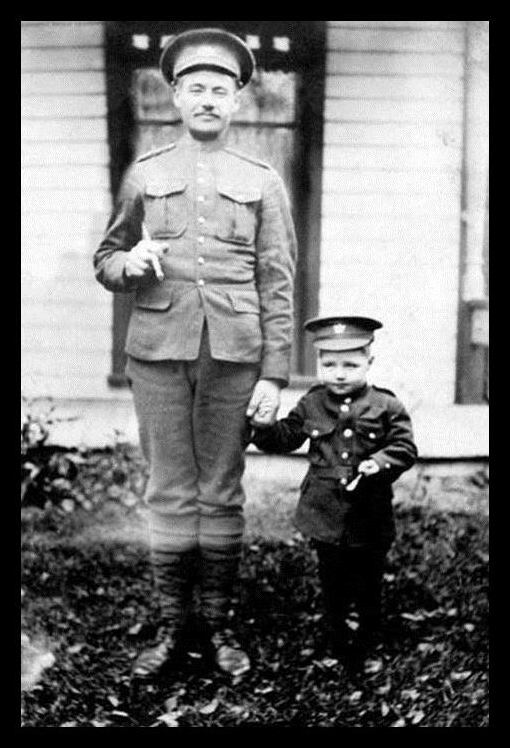 Private H. Kearse who lived on Brant Avenue died in World War 1. He left his wife and 3 young children in Burlington, so he could fight in France with the 86th Machine Gun Battalion. His death was reported in the newspaper before Private Kearse’s widow was officially notified. The last time this hero saw his family, was when he waved goodbye to them at the Freeman Station. When our boys left, there was not a dry eye to be found anywhere. When Canada answered the call to go to war, Burlington did its part. One hundred years ago, as World War 1 began, with a population that was less than 2,000, Burlington sent 300 sons. We responded in World War 2, and sent even more. The boys went to defend our freedom, and the town proudly marched them up Brant Street and onto the train cars at the Freeman Station. Some did not return. Their names are remembered at the Cenotaph on the grounds of City Hall.
Before Los Vegas, there was Burlington!
Most people do not know that in the 1890s and for another 30 years, Burlington was regarded as one of North America’s hot vacation playgrounds, especially for wealthy Americans. One of Burlington’s favourite sons, A.B. Coleman, who built and lived in the “Gingerbread House” on Ontario Street, was a wealthy entrepreneur who among other business endeavours, built and owned the Hotel Brant, the Brant Inn, Burlington’s first golf course on Francis Road, and developed most of the homes at historic Indian Point, mainly for the benefit of wealthy Americans and Europeans.
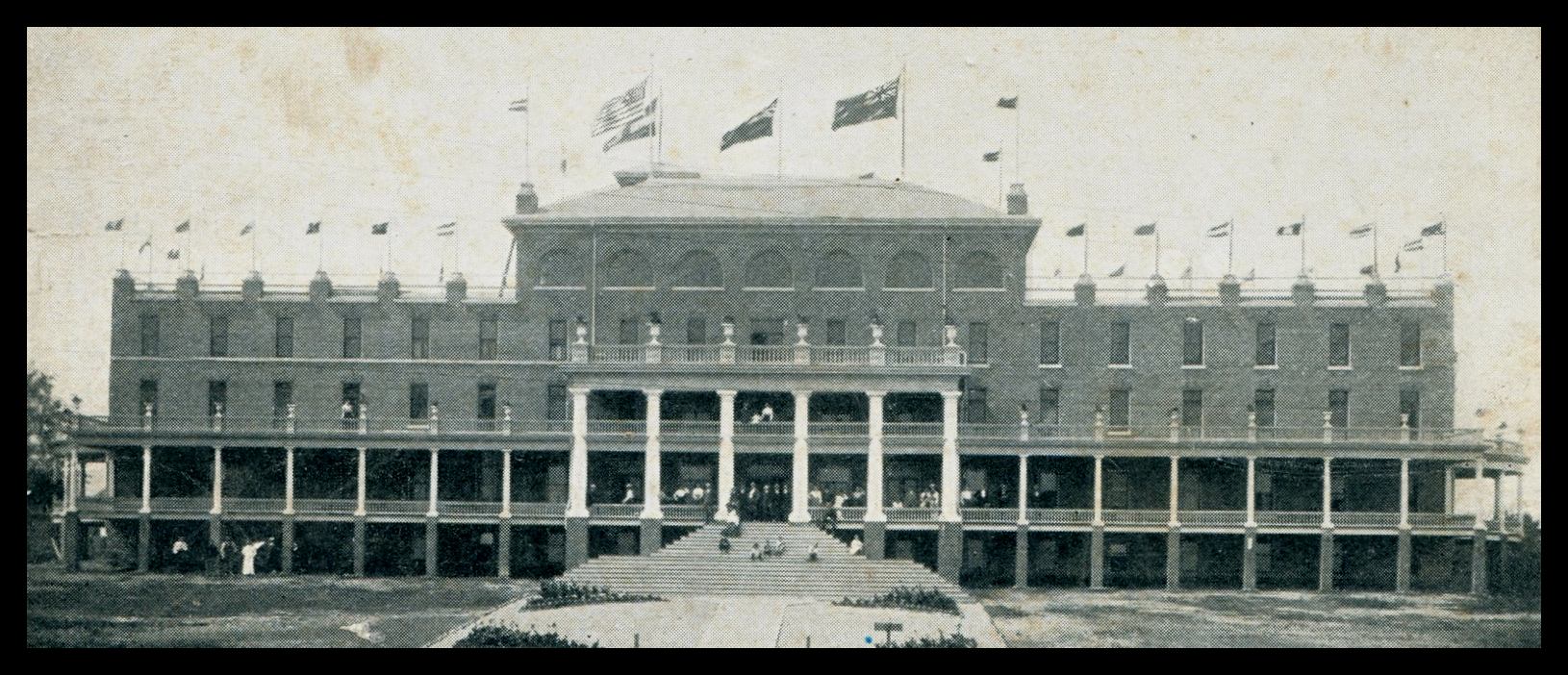 The Hotel Brant was a beautiful 5 Star hotel that overlooked Lake Ontario. The developer and proprietor, Burlington’s A. B. Coleman was the man responsible for stimulating the tourist industry in Burlington. He advertised the Hotel Brant all over North America and Europe, as the perfect summer vacation destination. Tourists flocked to Burlington. Most arrived by the Grand Trunk Railway and stepped off at the Freeman Station. The Hotel Brant, in the Garden of Canada, was advertised all across North America, and even Europe, as the perfect summer vacation destination. The 200 room hotel offered beautiful cool summer breezes, a roof garden, fishing, bathing, bowling greens, ping pong, billiards, boating, canoeing, golf, tennis, swimming, even furnished bungalows.
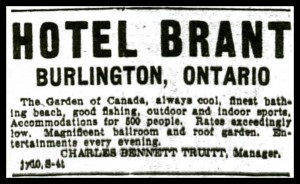 Wealthy Americans and Europeans were lured to the Hotel Brant by an intensive advertising campaign. This advertisement appeared in the Washington Post on July 17, 1904. Tourists from the United States, Europe and from across Canada flocked to the Hotel Brant. How did they get here? Most came by train and disembarked at the Freeman Station. Burlington at one time, with only a population of about 1500 people had 4 train stations. One was in Tansley, one in Aldershot, and the 4th, the Burlington station, not to be confused with the Burlington Junction station, was across the street from the Brant Inn and Hotel Brant and it too received many tourists destined for the Hotel Brant. Sadly, we have demolished the Tansley station, the Aldershot station, and the Burlington station downtown, leaving only the Freeman Station for us to enjoy today.
The Hotel Brant came to its demise when the Government of Canada expropriated the building in 1917 and converted it into the Brant Military Hospital, as a facility to care for our injured soldiers returning from overseas after World War One. The Brant Military Hospital was eventually demolished. Today, it is the site of the Joseph Brant Hospital.
The Brant Inn, a world famous entertainment mecca
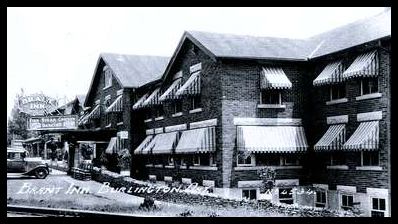 The Brant Inn was known all over North America and parts of Europe as a great entertainment destination. The owner A. B. Coleman brought in world class singers and musicians to entertain the patrons. If you wanted to see these performers in person, most arrived by train. Even the performers came by train to the Freeman Station. Undaunted by the loss of the Hotel Brant, A.B. Coleman turned his attention to his other moneymaker, the Brant Inn, which was located just across the street. The historic Brant Inn which was demolished in 1969 was to become one of North America’s greatest venues for entertainment. Almost every single major musician and singer from the 1920s up to the big band era and beyond, played the Brant Inn. The Brant Inn was advertised all across North America as the place to be to see the world’s greatest entertainers perform in person. If you couldn’t get to Burlington to see your favourite entertainer live, you could always hear them on radio. Their performances were broadcast live right across North America. For those that travelled to Burlington from somewhere across North America or Europe, you usually arrived by train and stepped off at the Freeman station.
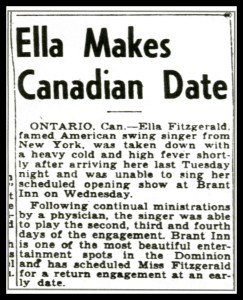 The Brant Inn received continuous publicity all over North America and Europe. This story about Ella Fitzgerald appeared in the Pittsburgh Courier on August 2, 1947. Burlington was a famous tourist town, as well as being an agricultural community. With a population just like a village, Burlington responded to the tourist trade and had several hotels ready for weary guests. Outside of the Hotel Brant, Burlington had three more on Brant Street. You could stay at the Hotel Raymond, or the Queen’s Hotel, and if they were full, you could find accommodation at the Burlington Hotel. These were the earliest hotels, and later on, many more were built.
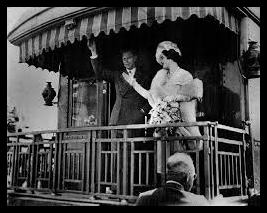 King George VI and Queen Elizabeth stopped at the Freeman Station in June 1939, as part of their cross Canada tour. It was the only time British Royalty had ever been to Burlington. The Royal Family stopped to visit Burlington at the Freeman Station
King George VI & Queen Elizabeth arrived in Canada in 1939. The Royal family were invited to tour right across Canada and into the United States. This was the first time British Royalty had ever been to either country. The Royal couple in the month of June stopped in Burlington to say hello to the thousands of residents who showed up to catch a glimpse of the two as they waved to everyone while visiting at the Freeman Station. The King and Queen were on their way to St. Catharines to officially open the Queen Elizabeth Highway. For local residents, this was to be their only time to see Royalty in Burlington. The British Royal family have never returned to Burlington. It was an historic moment at Freeman Station 76 years ago.
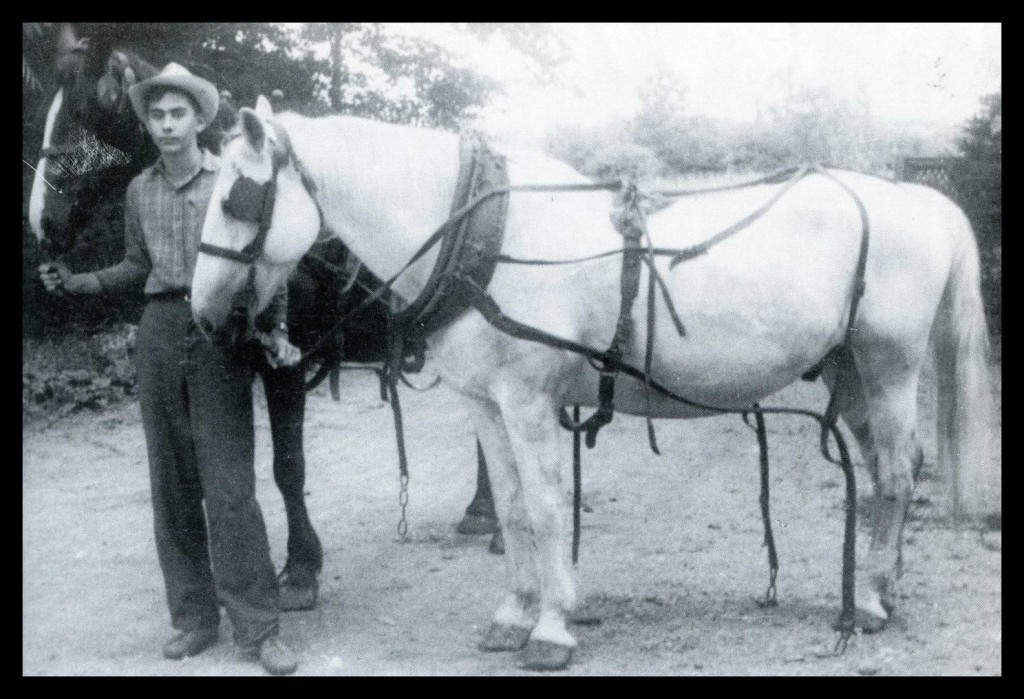 World famous author Peter C Newman arrived with his family from Austria to the Freeman Station after World War 2 to start all over again. The ravages of war had left the family with nothing. Their new life began on a local farm in Freeman. This photo from around 1946 shows Peter in Freeman with his favourite farm horses Bob & Joe. Welcome to Canada, your new home
Canada was founded on immigration. Burlington received not a few, but thousands of new residents over the decades. They came for many different reasons. Economic hardships in Europe, the ravages of war, new war brides, a chance to start a new life in a new land, were all catalysts that brought us these inspirational people. Most came with nothing, except the clothes they were wearing, and maybe a suitcase, and that was it. When they stepped off the train at Freeman Station, and looked around with some fear in their eyes, little did they know what was in store for them in Burlington. But, every single new immigrant will always remember the Freeman Station, where their new life began in Canada.
Tomorrow, find out what the Freeman Station symbolizes, and why it is historical.
Mark Gillies is a lifelong resident of Burlington, who grew up in Aldershot and developed as a local historian, researcher, master genealogist and writer who has a passionate interest and extensive knowledge of the many early pioneer families. Mark writes a regular column about colourful local history introducing Burlingtonians to the people that made this city what it is today.
Part 1

 By Mark Gillies By Mark Gillies
February 11, 2015
BURLINGTON, ON
If you’re like me, you really enjoy living in Burlington. We live in one of Canada’s wealthiest communities. We are also fortunate to live in a community that has a rich historical past. No doubt about it, this city has a lot going for it, yet at the same time, there is still much more room for improvement. As an historian, I have never seen so many in one community so determined to obliterate its historical past. What a shock! Over the years our local demolitionists have done a good job, there is not much remaining from the 19th century. Many Burlington buildings from the early 20th century now appear to be targeted too, even if they have historical recognition. The demolitionists continue to win most battles. The preservationists continue to lose most battles. Future generations will be denied the right to much of their heritage.
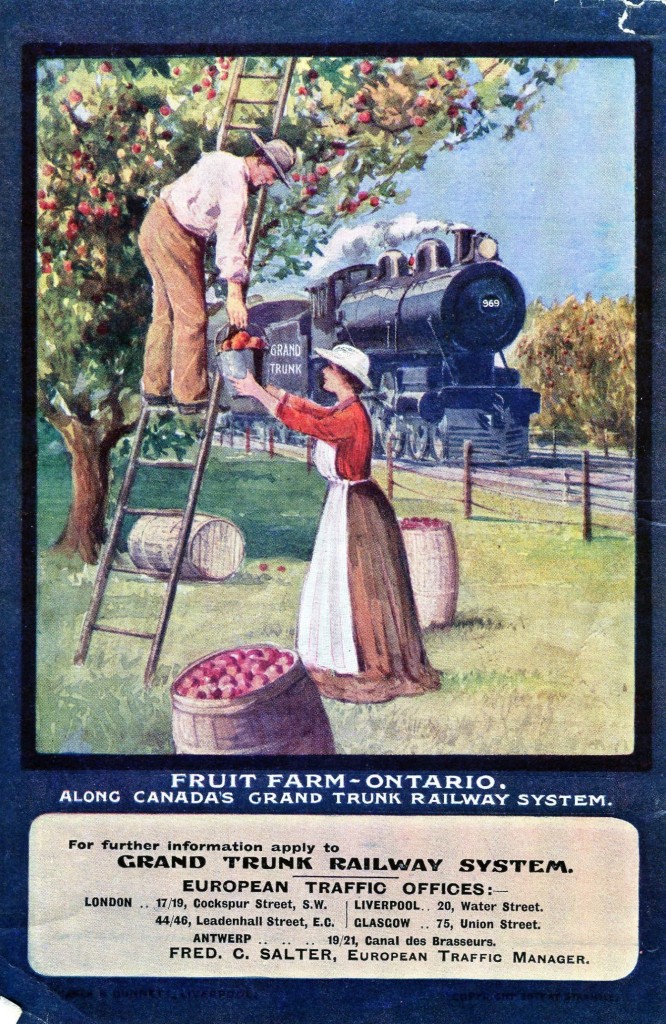 Burlington was put on the map with the combined efforts of the Grand Trunk Railway and our market gardeners, with both moving us quickly into the 20th century. This extremely rare full colour advertisement (only 1 remains) was inserted into European newspapers at the turn of the century, as an enticement to stimulate European immigration to the Garden of Canada. There was a point in the recent past when the city of Burlington was prepared t sell the Freeman station for kindling to anyone who would cart it away. A city engineer stood before Council and said the build was structurally unsound and could literally fall apart any day. What that engineer did not know was this: much of Burlington’s current wealth is due in no small measure to the existence of the railway station at the Burlington Junction.
But hey! Who cares about historical buildings?
We have to give credit to local organizations like the Burlington Historical Society who work hard at documenting some of Burlington’s rich historical past, and they must become completely frustrated when there is nothing available to fill in the missing parts of our local heritage. Without their efforts, few of us would know anything at all about some of our glorious history. There are a couple on City Council who try their best to keep some of Burlington’s historical buildings relevant, and free of a wrecker’s ball. They can only do so much.
There are a few local citizens and businesses who thankfully come forward and voice their concerns in opposition to historical buildings facing demolition, and there are those who operate our two museums doing their best to showcase our past. There are some dedicated homeowners of historical residences who do their best to preserve the historical aspects of their property. Outside of these few, there seems to be an overwhelming desire to rid the landscape of anything that is old, and replace it with something else. This could be a new hi-rise condo, a hotel, a plaza, a factory, an oversized house, or anything else that may generate new tax revenues.
Don’t get me wrong, I’m not anti-progress; I’m really pro-heritage. I believe that as a society we have to do much better to harmonize the two together. The answer is to not always knock old buildings down, that’s too easy, and it’s cowardly. The intelligent and correct answer is to work with our historical properties and responsibly integrate them into today’s world.
Why is this desire to destroy everything old happening in Burlington? I believe it can be summed up in one word, “ignorance”. There are those from within the general public, some members of our own City Council, some employees at the City of Burlington, some in our educational system, some local developers, some in our own Heritage Burlington, even some departments within the provincial and federal governments who haven’t a clue about what is historical and what is worth saving in Burlington. What’s worse, many of them just don’t care.
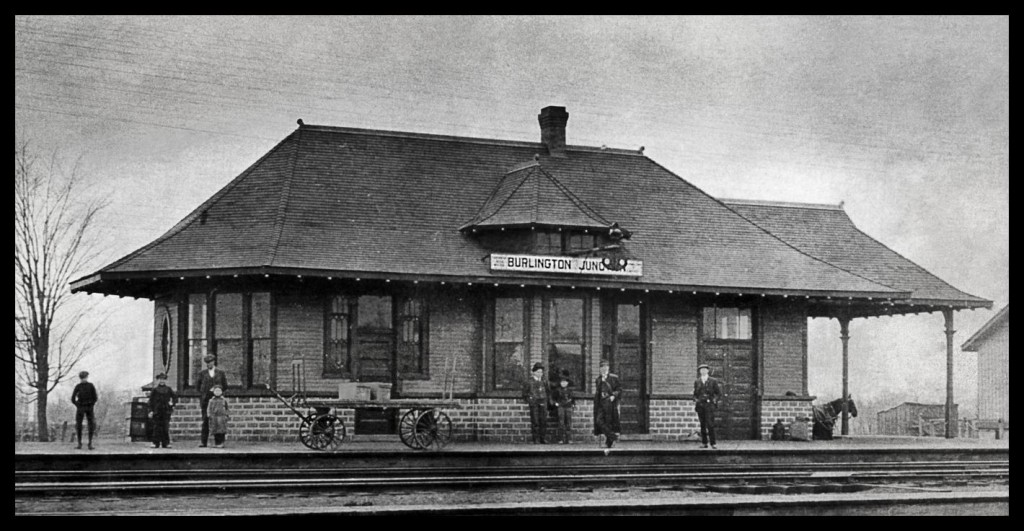 Residents are so fortunate to have the 1906 Freeman Station in Burlington. At 109 years of age, this building has outlived all of us. It is recognized provincially and federally as historical, but this city owned property lacks the will of our local government for any financial support. The Burlington Junction Train Station, or as it’s more commonly called, the Freeman Station, is a perfect example of how ignorance almost destroyed Burlington’s most historically significant building EVER.
The Garden of Canada made Burlington world famous
The Freeman Station represents the focal point of our community. Our whole local society and lifestyle, over several generations, can be worked around our local train station. Without the presence of the Grand Trunk Railway which ran their double tracks through Burlington, stretching from Montreal to Chicago, and with their other track running across the Beach Strip into Hamilton, the Niagara Region and into the United States, Burlington would probably not exist, as we know it today. Prior to the establishment of the predecessor railway through Burlington by the Great Western Railway, co-founded by Hamilton’s Sir Allan Napier MacNab, and Peter Carroll from Aldershot, goods were shipped by sailing vessels.
In the 1850s era, it was not uncommon to see wagons loaded with lumber lined up for over a mile waiting to be unloaded at the wharf located at the bottom of Guelph Line, and during the same period, they even backed up Waterdown Road at Brown’s Wharf in Aldershot. Over time, roughly 2-3 decades, when the timber had all been harvested, and the lands cleared for farming, the second local economic base became wheat, shipped first by sailing vessels, then by rail. When the Canadian west opened up in the 1870s & 1880s with free land available to new settlers, many of our local wheat farmers moved to the prairies, and wheat ceased to be a local crop. This left Burlington and surrounding areas looking for a third economic base.
Established farmers and even new settlers decided they would try other agricultural products. Their choices were fruit and vegetables. As it turned out, this was just about the most perfect location in all of North America for a wide variety of food production. The soil conditions, the temperature, the growing season, everything was perfect for great harvests. In short order, Burlington had thousands of acres of flourishing apple, pear, peach, plum, and cherry trees, plus strawberries, melons, tomatoes, beans, celery, cucumbers, and countless other fruits and vegetables under cultivation producing vast quantities.
There were market garden farms covering Aldershot, Freeman, Nelson, Appleby, Port Nelson, Kilbride, Lowville, Campbellville, Tansley, Zimmerman, all villages surrounding Burlington, with the Freeman Station at the heart of the whole area. Our area was a market gardening mecca, so much so, that Burlington became known around the world as “The Garden of Canada”. The harvests were so bountiful, that Burlington shipped produce to Hamilton and Toronto, and when we saturated those two markets, the market gardeners expanded some more, and shipped all over Ontario, and then it was all across Canada, followed by Europe, and then it was South Africa. Burlington was helping to feed many parts of the world. The name “Aldershot melon” became just as famous internationally as the well known “Idaho potato”.
Just in time delivery started with the GTR at Freeman Station.
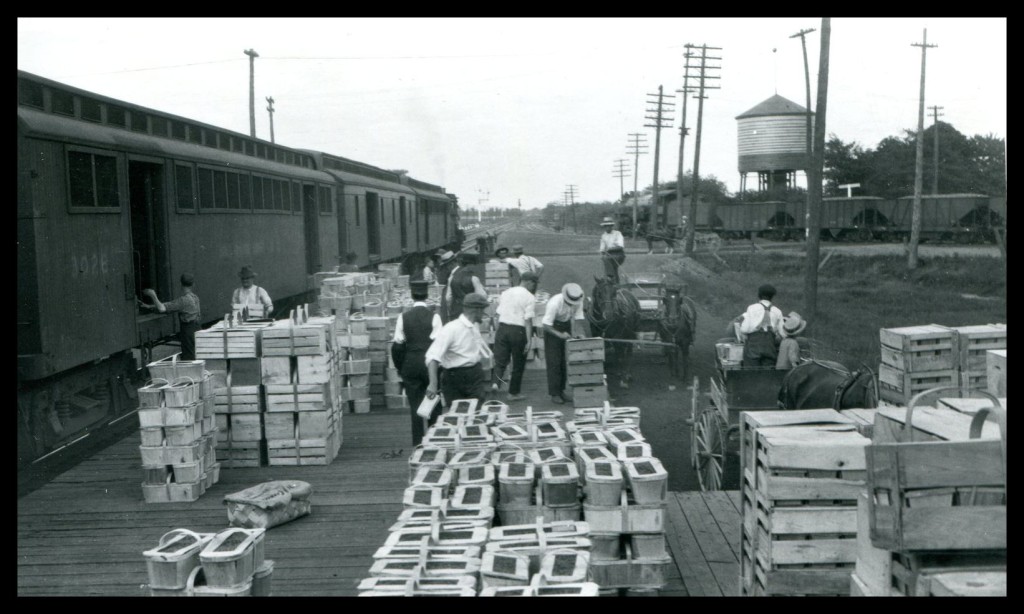 What made Burlington wealthy in the early part of the 20th century was the ability of the local market gardeners to get their high grade produce to the Grand Trunk Railway’s Freeman Station and have it shipped across the country and around the world, arriving just as fresh as when it was picked. How did our market gardeners get this fragile produce to these destinations? The 1906 Freeman Station which is now being restored and re-located to Fairview Street, was the focal point for most of this growth. Previously, there were two other train stations in Freeman which were destroyed by fire, one in 1883 and the other in 1904. They also played a part in this new economy. If it wasn’t for the railways in Burlington, the local wealth generated would not have happened. Burlington became very affluent at the turn of the 20th century, due to the efforts of the Grand Trunk Railway to quickly move the product, the local development of refrigerated boxcars, and also, our market gardeners who comprehended the science of agriculture, and maximized their yields. But, this was just one part of the Freeman station’s significance to Burlington. There were many more.
Tomorrow, find out how the Freeman Station played different roles in Burlington during the early part of the 20th century.
Mark Gillies is a lifelong resident of Burlington, who grew up in Aldershot and developed as a local historian, researcher, master genealogist and writer who has a passionate interest and extensive knowledge of the many early pioneer families.
Mark writes a regular column about colourful local history introducing Burlingtonians to the people that made this city what it is today.

 By Walter Byj By Walter Byj
February 11, 2015
BURLINGTON, ON
Burlington school Board trustee Andrea Grebenc, who hasn’t been a trustee long enough to cash the first paycheque found herself managing questions on the issue of a possible change to high school start times.
 Andrea Grebenc gets handed a hot potato – defers a decision at committee level. A good chair in the making. It was an auspicious debut on Monday night in her role as chair of the transportation committee for the Halton District School Board (HDSB).
Late last year, a motion was passed by the board requesting that the Halton Student Transportation Services (HSTS) do a study that would look at high school start times and to realign bussing to all high schools to a start time between 8:45 am and 9:15 am.
The due date for the report was for March of this year.
Karen Lacroix, General Manager of the HSTS, responded with a letter listing a number of questions and requesting additional information before any study would be initiated. The discussion was the highlight of the meeting.
Most school board meetings can be very procedural and quite dry. Not this meeting. With Lacroix in attendance and the trustees quite aware that any change in school hours, both elementary and secondary could be quite contentious to the public, ideas and comments were coming from every direction.
If secondary school hours started later, would elementary hours start sooner?
How much later could secondary school start and when would classes end?
How would this affect after school athletics?
How would this affect students with after school jobs?
If elementary schools hours were changed, how would this affect daycare before and after school?
How would this affect special education busing?
What about schools with grades 7 to 12?
What would be the cost of this study?
How will this affect the teacher’s timetable?
All valid questions.
 These questions led to a discussion of class minutes (74), the length of the school day, travel time between classes and the overall school day. Every trustee at the meeting was a full participant – it seemed that each was learning something new. These questions led to a discussion of class minutes (74), the length of the school day, travel time between classes and the overall school day. Every trustee at the meeting was a full participant – it seemed that each was learning something new.
Throughout the meeting, there was no opposition to delaying start times for secondary students.
Board chair Kelly Amos, Oakville, is a strong advocate of this change and the board is in agreement.
The question is how this would be done with the least disruption.
The committee did give some parameters to Lacroix for her study. Any time changes should not be more than 30 minutes from the current start times.
The study however is still on hold until one piece of the puzzle is resolved.
Burlington trustees Collard and Reynolds, asked that the proposed study be put on hold until the HDSB is advised if the Catholic board will also want to delay their starting times for their secondary students.
Depending on that decision, the HDSB might have to decide if they have a partner in school times or if they might need to go it alone.
Either way, before a final decision is made, there will be many more meetings to follow as no doubt the public will want their say.
Editor’s note: We appreciate that not all the people who attend the HDSB are protestants; historically the board has been referred to as the “protestant board” while there is a different school board for Catholics. With our society much more diverse perhaps it is time to look for a more descriptive name. Protestant was used for purposes of a headline

 By Staff By Staff
February 7, 2015
BURLINGTON, ON
We hear radio announcements about a Weather Alert. We read about people freezing to death in a bus shelter – we shake our heads and wonder – why do things like this happen. Do we not provide places for these people to go to be warm and get fed?
We do – but those “places” don’t just spring up like tulips in April. They happen because people spend hours working out a program and even longer hours making phone calls asking for donations.
 This is what cold is all about. There is an event that takes place happens in over 80 cities across Canada. This is the first time it is being held in Burlington. Open Doors @ St. Christopher’s is the location host this year. The event is called: The Coldest Night of the Year. It will take place on Saturday February 21st
Open Doors is trying to raise $25,000 to support its 13 programs: they still need your help. They are half way there thanks in part to their lead sponsor the Leggat Auto Group , but still need community and businesses to sponsor , walk or volunteer.
The Leggat Care Foundation is an established member of the community; they have put an emphasis on health care, poverty reduction and education opportunities as the paramount pillars of the Leggat Care Foundation.
Other businesses and partners are JD Restorations , Goodness Me Natural Food Market, Halton Public Library -Central Library and Halton District Catholic School Board. The Burlington Police , Neo1 Paint , and St. Luke’s Palermo Youth Group are some of our partner’s walk teams.
In 2014 Open Doors provided over 45,000 meals to our community. over 2000 people accessed free clothing through Open Doors and 142 families were helped at Christmas.
 The sign says it all. This ad has a place to go to get out of the cold. Open Door Programs and Networks
The programs in place now are:
Partnership West Food bank @ Open Doors ; Free Clothing Store; Kids Club After School Program; Tweens Club After School Program; Active Tots – (2015 start); Respite Programs for Families with Children with special needs; Calling All Parents Parenting Workshops; Christmas Program; Tuesday Night Dinner; Seniors Lunch; Halton Fresh Food Box Distribution; Pop Up Farm Markets with Feeding Halton; Community Kitchens (Youth and family) and the Halton Meal Network
Is Burlington now part of the Coldest Night of the Year walk because the need is now greater or is it because Burlington has become more conscious of the need?

 By Staff By Staff
February 6, 2015
BURLINGTON, ON
The Art Gallery of Burlington (AGB) is launching its new self-guided tour program to assist gallery visitors in enjoying more of what the AGB has to offer. This new approach begins Saturday.
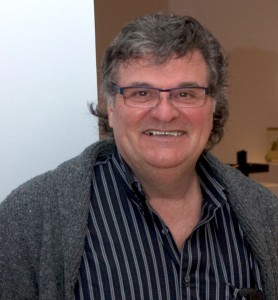 Chief Curator Denis Longchamps “Chief Curator Denis Longchamps is raising the quality of AGB’s exhibition offerings throughout 2015,” says Interim Executive Director Anne Swarbrick. “This Sunday’s public reception formally launches Of Water and Tides by international artist Lyndal Osborne, linking the environment and the arts. At the same time, visitors will be able to follow the new self-guided tour programme to savour exhibitions in the AGB’s two other galleries, the Permanent Collection Corridor, and reflect upon Sally Michener’s fun ceramic installations with coffee in The Conservatory.”
Lesley McInally’s Passage exhibition in the Perry Gallery possesses evocative powers that drive the viewer to decode the narrative elements which she hints at but never states.
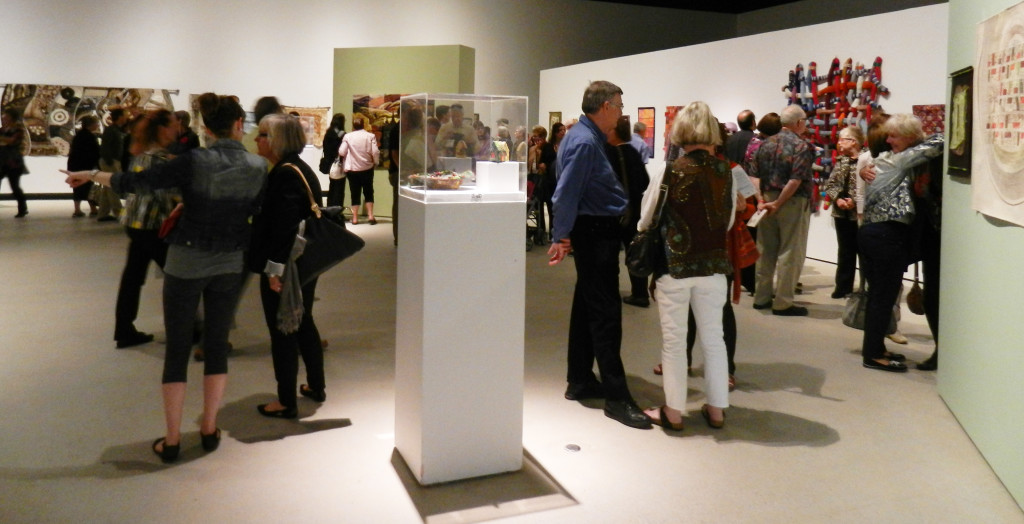 Thousands of people from out of town visit the AGB every year. HomeGrown, winding through the Permanent Collection Corridor, draws from the AGB’s nationally significant 2,400-piece Collection of Canadian Ceramics. This exhibition by award-winning Curator Jonathan Smith traces the history of ceramics in Ontario over the last forty years. Starting with the refined functional ware of Ruth Gowdy McKinley and her effect on the program at Sheridan College and elsewhere, this exhibition looks at the development of the more sculptural approach by younger artists such as Reid Flock and
Mary Philpott. Flock is the third of the thirteen recipients of the Clay & Glass Gallery’s prestigious Winifred Shantz Award for Ceramics whose successful career first started in the AGB’s pottery studio. The others are Kasia Piech and Ying Yueh Chuang.
Gallery visitors will be awed by Osborne’s installation throughout the AGB’s Lee-Chin Family Gallery. Longchamp’s 2015 engaging programme year will also include Naked Craft, an initiative with Canadian and Scottish artists that he has scheduled to tour Halifax and Quebec City; and In Spirit a collaboration with Owen Sound’s Tom Thomson Gallery that will tour work from regional artists throughout Burlington, Owen Sound, Woodstock and Montreal.
The bills do have to be paid. Admission to the AGB has been free for a location that is basically open every day of the year. 
The AGB will encourage visitors to assist through a suggested admission initiative. Noting that approximately 80% of Ontario’s art galleries charge admission fees, the AGB points out that members and children 12 and under can visit all exhibitions, as often as they like, free and take advantage of the self-guided tour. Non-members and new visitors to AGB will be asked to contribute $5 to tour the multiple exhibitions.
You just know that suggested is going to become mandatory – and perhaps that is the way it should go. The people that make the AGB work financially have done a great job without having to put in an admission fee. If it could be kept at $5 for a few years that would work.
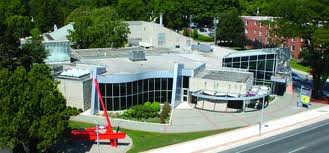 The Art Gallery has grown over the years with pieces added on. It has a charm and a character of its own – and sits on some of the most valuable land in the city. The AGB stages as many as 10 regional, national and international exhibitions a year and is home to the world’s largest, acclaimed collection of Canadian contemporary ceramics and seven fine craft guilds. An interactive and creative space, they provide art education programs and public tours for people of all ages. Spanning over 44,000 square feet, the space boasts seven equipped art studios, three galleries, a one of a kind gift shop, an exhibition courtyard and year-round conservatory.
Gallery Hours:
Monday – Thursday: 9:00 am – 10:00 pm
Friday – Saturday: 9:00 am – 5:00 pm
Sunday: 12 noon – 5:00 pm
The Art Gallery of Burlington is located at1333 Lakeshore Rd, Burlington, ON L7S 1A9
Art Etc Gallery Shop and Art Sales and Rental Hours:
Monday – Thursday: 10:00 am – 6:00 pm
Friday and Saturday: 10:00 am – 5:00 pm
Sunday: 12 noon – 5:00 pm
At $5 a pop – the AGB is one of the best entertainment offerings in the city.

 By Walter Byj By Walter Byj
February 5, 2015
BURLINGTON, ON
The anticipated discussion around the letter Karen Lacroix of the Halton Student Transportation Services consortium sent to the Halton District School Board got a couple of minutes discussion before it was shuffled off to the Transportation Committee where Burlington trustee Andrea Grebenc will do her best to come up with some of the answers to the question Lacroix asked.
 Halton District School Board chair Kelly Amos brought up the idea of later start times for high school students. Will it get any traction? Board Chair Kelly Amos put out the idea of later starting times for high school students who apparently don’t function all that well before 9:00 am.
Rather than having a full board discussion on the issues raised by Lacroix, they refereed the discussion to the transportation committee which will meet on Monday February 9th. Should be an interesting meeting. Not sure if the transportation committee is going to be able to fully address all the issues presented by Lacroix.
School boundaries:
While the Toronto school board is incurring the wrath of the provincial government for budgetary problems and is faced with the problem of how many schools it should close, the Halton School Board seems to run like a well oiled machine where defining new school boundaries takes up much of the time.
With two new schools scheduled to open for the upcoming school year, one in northeast Oakville and the other in southwest Milton, the superintendents took the board through the process of arranging school boundaries for the new schools.
In Oakville, with eight parents representing the community, the Boundary Review Committee held a total of six community meetings and at one time had a total of 22 boundary change scenarios which they eventually narrowed to one recommendation.
The new school located north of Dundas and to the east of Neyagawa, would alleviate the overcrowding of nearby schools River Oakes and Sunningdale. This would require some students crossing Dundas Street. This created a number of trustee questions and comments.
 Ward 2 Burlington Councillor Marianne Meed Ward with school board trustee Leah Reynolds on the right share a laugh during a nomination meeting last fall. Is Reynolds developing her political skills as a possible city council candidate in 2018 when Meed Ward is expected to run for Mayor? Oakville trustee Oliver, a proponent of neighbourhood schools and observing natural boundaries questioned why children would be crossing Dundas Street . Burlington trustees Andrea Grebenc and trustee Harvey-Hope of Oakville wanted assurance that students would not need to cross a six lane road and that busing would be available.
Burlington trustee Leah Reynolds questioned if public input was sufficient. Superintendent of Education, Julie Hunt Gibbons, assured the trustees that the committee has made a strong rationale recommendation that best balances enrollment in the three schools that are affected. She also added that another possible five schools could be anticipated in the near future.
The same thought process and community participation was also evident for the new school in Milton. For all three current schools, PL Robertson, Anne J. McArthur and Tiger Jeet Singh, the current accommodation will be somewhat alleviated this year. This committee met four times with the public and narrowed 18 scenarios to one. The current boom in housing is expected to result in an additional new school by 2017.
Much of the balance of the meeting was reviewing an update Closing the Gap report which identified and ranked which schools would receive up to $10 million in upgrades for Information Technology equipment, library services, special education rooms, specialty classrooms and air conditioning for the second and third floors in both elementary and secondary schools.
Plans for new schools in the Region don’t include Burlington – do they. This city is building high end retirement homes for Seniors and looking for ways to attract those high tech, high paying jobs everyone wants. Burlington did however get the complex in Alton that is made up of a high school, a public library and a recreational centre – all of which are heavily used.
Related articles:
Changing bus schedules for later high school start times: more questions than answers.

 By Staff By Staff
February 4, 2015
BURLINGTON, ON
The Burlington Beer Festival – a two season event – will be holding it’s winter season at the Waterfront Hotel Friday and Saturday of this week.
 Two programs – a full scale beer tasting and pairing event – tickets are $125 each and then the Saturday session from noon to 11 pm – where you can taste a solid section of craft beers. Two programs – a full scale beer tasting and pairing event – tickets are $125 each and then the Saturday session from noon to 11 pm – where you can taste a solid section of craft beers.
No American big brands names at this event.
Friday February 6 – begins at 6 – runs till 11 guests will participate in an exclusive three-hour tutored pairing, where they will be guided by an esteemed panel of speakers through seven small dishes, each accompanied by unique beers from premium craft breweries. The Master of Ceremonies for this evening is Bill White from Niagara College, who will share his passion and knowledge of beer over the course of the event. This special event will provide beer connoisseurs with a unique opportunity to engage with members of the craft beer community, and get a more in depth look into the craft beer industry. $125 a ticket.
Saturday February 7th – Winter Beer Fest – noon-11 pm
$25+HST [Includes five 4 oz. samples and a Winter Fest tasting mug]
On Saturday, the indoor/outdoor space of the Waterfront Hotel Ballroom will be transformed into a beer fans paradise, where Festival-goers are invited to sample an array of products offered by 10-12 talented local brewers, warm up with winter comfort foods and enjoy live entertainment all day.
Wayne Brown is the mind behind this event. While relatively new to the city – it has attracted a growing following.

 By Staff By Staff
February 4, 2015
BURLINGTON, ON
Ward 4 Councillor Jack Dennison knows a good local issue when he sees one: Coyotes.
The creatures are showing up with more regularity than usual. One city resident watched in horror as a coyote killed her pet.
 Coyote about to pounce on a mouse scurrying beneath the snow. It’s an emotional issue – and there is nothing more effective than an emotional issue to get the folks out for a meeting. A good politician can make good political mileage out of emotional issues. Dennison’s Ontario Municipal Board hearing later in March will be another that ward four residents will be watching; many would have liked that hearing to have taken place before the municipal election.
Dennison is holding two public meetings on the issue – he has held this kind of meeting before – the Gazette has reported on these in the past.
Dennison has positioned the meeting as an “opportunity for you to provide feedback on a proposed new by-law that would prohibit the feeding of nuisance wildlife (i.e. coyotes, raccoons, skunks, chipmunks, foxes) in our city.”
There will be a meeting in North Burlington on Wednesday, February 25, 2015; 7 to 8:30 p.m. at Tansley Woods Community Centre, 1996 Itabashi Way, Community Rooms 1 and 2
Another in South Burlington: Thursday, March 26, 2015, 7 to 8:30 p.m. at Central Arena, 519 Drury Lane.
There are some that might take issue with Tansley Wood being described a “north” Burlington. The northern part of ward four would be more correct.
Previous articles on coyotes.

 By Walter Byj By Walter Byj
February 4, 2015
BURLINGTON, ON
Kelly Amos, Chair of the Halton Region District School Board mentioned to her colleagues a study done by the American Academy of Pediatrics that recommended schools delay the start of classes to no sooner than 8:30 am.
That brought about some lengthy comment and close to a can of worms of problems.
 Amos took the information she had found a little further and recommended that the Halton Student Transportation Services (HSTS) research the possibility of realigning busing to all high schools to accommodate a later secondary school start time to any time between 8:45 and 9:15 am. Currently, secondary school start times in Halton vary between 8:05 am and 8:40 am. Amos took the information she had found a little further and recommended that the Halton Student Transportation Services (HSTS) research the possibility of realigning busing to all high schools to accommodate a later secondary school start time to any time between 8:45 and 9:15 am. Currently, secondary school start times in Halton vary between 8:05 am and 8:40 am.
Many pediatricians have argued that since students are not getting the up to 9 hours of sleep that is recommended, school start times should be moved back as students tend to be up late in the evenings. This is a greater concern in the US than in Canada as many US students have school day starts in the 7:00 am to 8:00 time period.
Was there unified opinion by the principals on this issue? Not yet.
How would this affect after school activities. To be determined.
Did an American study pertain to Canada? Maybe, we are not that different. Would this include the elementary students? Not at this time. Would this include the Catholic School Board? Talks are still in the preliminary stages.
The Transportation services would need to do, what could be a lengthy study on how to best realign the busing services. The busing handles both elementary schools and the Catholic board. A change to one would affect busing timetables and perhaps costs to the entire system. The school board is hoping for a report hopefully in March with the details and ramifications of any changes. They didn’t get a report – they got a letter that asked a lot of questions the trustees might have thought about before they passed the motion. Somehow the HRSB managed to place the cart before the horse with the following motion:
Be it resolved that the Halton District School Board request the HSTS to do a study that would look at high school start times and to realign busing to all high schools to a start time roughly between 8:45 a.m. and 9:15 a.m., and attempt to bring an interim report back to the Transportation Committee in March 2015 with the details and ramifications.
Shouldn’t the entire school boards, elementary, secondary and Catholic all be in agreement before further analysis? What percentage of principles would want a time change before changes are made? And what about the students, should they be consulted?
Along with the Motion were two recommendations:
Be it resolved that the questions identified in Appendix A be forwarded to the Transportation Committee in order to provide direction on the parameters required to complete the study.
Be it resolved that the Chair of the Halton District School Board contact the Chair of the Halton Catholic District School Board to assess their interest in participating in the study.
Karen Lacroix, General Manager of the Halton Student Transportation Services (HSTS) sent Lucy Veerman, Superintendent of Business Services and Treasurer a memo; it’s a beauty.
The purpose of this memo is to request clarification and direction regarding Halton District School Board (HDSB) Report #14154 and the associated motion M15-004 requesting HSTS undertake a study of high school start times with the intent of moving all high school start times between 8:45 a.m. and 9:15 a.m. The motion also contained a request that an interim report be brought back to the Transportation Committee in March 2015 and that the report include details and ramifications.
As you are aware, the home to school student transportation system in Halton is fully integrated with the Halton Catholic District School Board (HCDSB). This means that virtually every bus route in Halton is shared between the HDSB and HCDSB in one way or another; either students from both boards ride together at the same time or the bus route consists of bus runs servicing one or more HDSB schools and one or more HCDSB schools.
Prior to undertaking a study of this scope and nature there are assumptions that must be confirmed and parameters that must be set. Unless otherwise directed, it will be assumed that the study will exclude the small bus routes that service students with special needs and that no changes to HCDSB school hours will occur as a result of this study.
In order to assist the board with setting parameters, HSTS staff have developed a list of questions:
1. What is the earliest and latest start time for both elementary and secondary schools?
2. Is there one preferred start/end time for secondary schools or is there flexibility to work within the range outlined in the report (8:45 a.m. – 9:15 a.m.)?
3. Can we continue to use a 30 minute drop off/pick up window for secondary students? (This is the standard across the province and the window that HSTS currently uses for secondary students)?
4. Can elementary start/end times be changed to accommodate the secondary school hour changes?
5. If elementary schools can be changed, what is the acceptable (maximum) time change, e.g. up to 15 minutes?
6. Are there specific schools that cannot be changed?
7. Should the secondary student average ride times be maintained or can they be increased but kept within the maximum travel time guidelines of 75 minutes?
Outlined below are other factors the board may want to consider:
1. There is a school bus driver shortage in Ontario, it is particularly challenging in the GTA. If the number of routes increase significantly, the level of service will most likely be felt across the system, which may result in late buses, different drivers and a potential for rolling route cancellations if there is no driver available.
2. There are many secondary runs that are shared between the boards. The shared runs will have to be eliminated if the HCDSB is not included in the study, this will result in a loss of some routing efficiencies.
The requested study is very complex in nature and there is not an easy or quick way to provide a summary or overview. In order to provide the board with a report that will allow them to make an informed decision a full review of all school start/end times and a full optimization of the bus routes should be performed. Once the bell time/route optimization study is complete, an accompanying financial impact study will have to be undertaken to understand the associated financial impact/savings on the HSTS operating budget.
Undertaking a study of this nature is complex and labour intensive; the study will require a thorough review and optimization of the student transportation system. At this time of the year when staff are not dealing with their daily transportation priorities, their main focus is on route planning for the upcoming school year which starts in February and continues through August.
In order for the board to make informed decision they must be provided a true picture of the impact, from both a school community/hour and financial perspective. HSTS staff has expressed concerns that a study of this nature will result in time and resources being diverted from their normal daily activities, including annual route planning, which is not ideal and could have a negative impact next September.
In order to have a report back to the board in April or May, HDSB may want to consider contracting out the route planning portion of this study; HSTS staff would undertake the financial impact portion of the study. In 2009 First Student Planning Solutions performed a similar study of secondary school hours for the HDSB. This approach would allow HSTS staff to focus on the daily operations and September 2015 route planning.
In conclusion, with the above approach the board could be provided a report in the spring that would provide them with the information required to make an informed decision.
Expect this issue to occupy hours of coffee chat between parents, even more hours of telephone calls between parents and trustees and perhaps some noisy delegations at school board meetings.

 By Mark Gillies By Mark Gillies
January 22, 2015
BURLINGTON, ON
Part 2 of a 2 Part feature
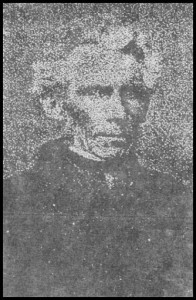 Peter Carroll 1807-1876 was a wealthy man, a land surveyor, a co-founder of The Great Western Railway, and a businessman who served on many corporate boards. When Rock Bay opened, it was spectacular to see. Peter Carroll had selected an ideal location for the mansion, overlooking Burlington Bay from the north shore line located at the far western end. Below the mansion sitting high atop its high ground, was a jut of land that ran way out into Burlington Bay. This land was to be known as Carroll’s Point, and the name is still in use today. You could say that Peter Carroll’s closest neighbour, towards Hamilton, was Sir Allan MacNab, who lived in nearby Dundurn Castle.
Peter Carroll loved to entertain. His wife was the former Henrietta Martin. They married in 1836. Together they entertained the wealthy and put on countless lavish galas. Most guests at the time lived in Hamilton, and they would ride to Rock Bay Castle in their fancy carriages from the city out to Peter and Henrietta’s estate, horses prancing along York Boulevard, across the Burlington Heights, turning right at the Valley Inn Road, proceeding down the hill, and then driving up to the front gates which were located just about where the Woodland Cemetery main entrance is now.
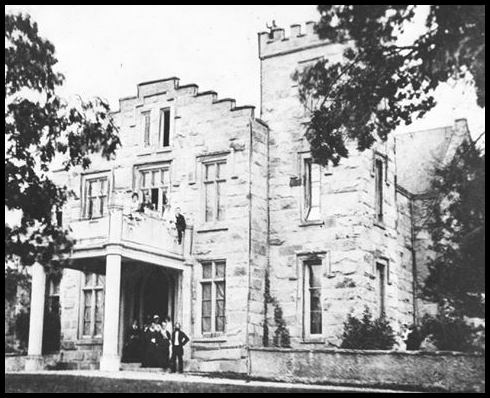 Rock Bay Castle was a mansion in Aldershot owned by Peter & Henrietta Carroll, a venue for high society galas. Guests, in this photo, can be seen enjoying themselves at Rock Bay Castle. The lane way to Rock Bay was long and it was winding. Colourful gardens adorned both sides of this beautiful lane. Peter had oak trees planted on either side of the lane. Over time, the oak trees provided a covered arch, all the way to the handsome port cochere. Many of these trees can still be seen on the Woodland Cemetery grounds. Stepping out of the carriage upon your arrival, there were many servants tending to your every need. As you walked up the steps to the front entrance way, the great wooden door would be opened for you, and then you entered into a beautiful wood paneled hall, and proceeded to one side into a circular reception hall, graced with a large fireplace. In the fireplace would be a fire, well-seasoned oak logs would be crackling and burning. This reception hall was 2 storeys high, and to one side was a circular staircase that led you up to a balcony with a window that overlooked the estate’s property.
From this same balcony room, several doors would lead you into the bed chambers. Rock Bay had a beautiful drawing room, and within it was something quite rare for Upper Canada at that time. It was a beautiful grand piano. The windows in the mansion were adorned with heavy curtains of brocade. To light the estate in the evening, scented candles were found to be everywhere. Beautiful family portraits painted in oil were hung on most walls inside this magnificent home. Rock Bay was breathtaking.
The focal point of Rock Bay was the exterior’s large square tower, similar to one seen on Scottish baronial castles.
When you were either entertained at Rock Bay Castle, by Peter & Henrietta Carroll, or at Dundurn Castle by Sir Allan MacNab, guests knew they were in a special circle of the elite, and from this, they had a chance to enjoy the benefits of high society.
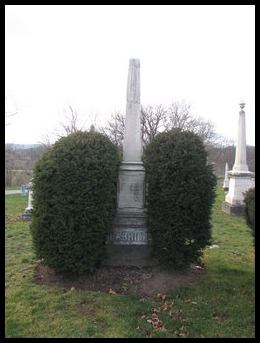 Peter Carroll’s monument is in historic Hamilton Cemetery. Peter died from small pox in 1876. His legacy is now forgotten. While Peter Carroll was on a business trip to France in 1876, he managed to contract small pox. When he returned home, he tragically died a few days later on September 18th. Henrietta, herself contracted small pox from Peter, but survived this attack. Peter was buried in Hamilton Cemetery. However, the importance of Peter’s death and his funeral were overshadowed by another event that captured all of the headlines in Canada and the United States. A man from Hamilton, named Cyrenius Chapin Roe, a machinist by trade, unveiled his invention that totally captivated everyone. Cyrenius was more commonly known as C.C. Roe, and his invention was patented as “Steam Man”.
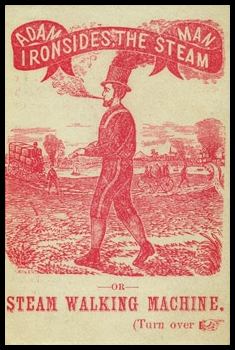 C.C. Roe from Hamilton invented the world’s first robotic man, called “Steam Man”. It took North America by storm. Many events of real importance at that time were relegated to the back pages of newspapers. This was the world’s first robotic man capable of walking upright, and “Steam Man” could perform feats of strength. The world was captivated by this man’s invention, spawning many articles and stories everywhere. C.C. Roe and his family travelled all across Canada and the United States with “Steam Man”, as people flocked to see this marvel of modern technology for themselves.
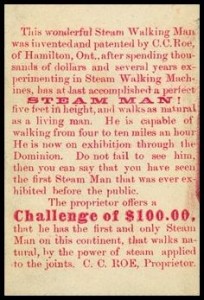 Henrietta, after recovering from small pox, continued to live at Rock Bay. When she became too elderly to live there on her own, she went to live in Hamilton. Henrietta, after recovering from small pox, continued to live at Rock Bay. When she became too elderly to live there on her own, she went to live in Hamilton.
There, Henrietta died of senile debility on July 20, 1907. While Henrietta, as a widow, was still alive and living at Rock Bay, my own grandmother Mabel Henrietta Hunter and her sisters, Lydia, Maud, Nellie, Ethel, Edna & Jessie, as young girls in the 1880s and early 1890s would play at Rock Bay with the jovial elderly lady. Henrietta Carroll taught the young girls how to make various crafts.
My great grandfather, Arthur Hunter, was an original Aldershot market gardener, and the Hunter family lived in Peter Carroll’s Bay View cottage as tenants. When my grandmother was born in 1883, it was at Rock Bay mansion. My great grandparents, Arthur & Elizabeth Hunter gave Mabel, my grandmother, the middle name Henrietta, in honour of Henrietta Carroll, a lady who was quite adored by the Hunter family.
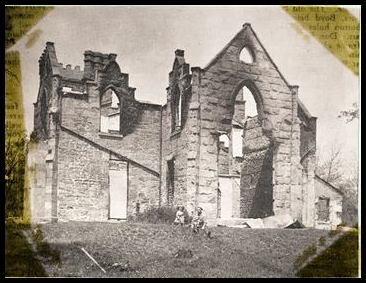 Rock Bay Castle suffered the fate of a devastating fire. Henrietta Carroll lost everything. The building was eventually demolished. The stone walls were crushed into gravel. And what became of Rock Bay? Sadly, this beautiful mansion burned to the ground around 1908. The stones from the building were crushed into gravel. Some say, that this same gravel was used for the new roads winding throughout Woodland Cemetery. This could be true, I do not know.
As for the name Rock Bay, where did that name come from? No one knows for sure. Some say, it was named after Peter Rock, who owned the Maple Leaf Hotel, located in the Market Square in Hamilton. I don’t believe that is true.
Peter Rock did not arrive in Hamilton, until around 1890, many years after the death of Peter Carroll. My own theory is, it was a combination from two sources. “Rock” could have been in reference to the stone from Queenston, used to build the mansion’s walls, and “Bay” would have been the reference to Burlington Bay.
What’s really unfortunate is Rock Bay Castle, this beautiful mansion from the 1850’s is no longer with us. We lost a beautiful jewel from the past.
Mark Gillies will next tell you about Harry Lorimer, another forgotten person from Burlington’s colourful historical past. A humble man, Lorimer made a huge impact on Burlington, not just once, but twice. Lorimer’s house at 504 Burlington Avenue was recently removed from the City’s Heritage Registry for lack of historical significance, a decision many find totally incomprehensible, myself included.

 By Pepper Parr By Pepper Parr
January 27, 2015
BURLINGTON, ON
The Halton Residents Against Sewer Backup (HRASB) is hosting a Valentine’s Day Gala with all proceeds going to fund independent research of the storm and sanitary sewer systems.
HRASB spokesperson, Christina Thorpe, says the group will spearhead the research but intends to work closely with independent experts who will analyze last year’s storm and waste water system failures, provide recommendations, and offer insight into the city’s proposed “intensification” plans.
 Christine Thorpe speaks for the Halton Residents Against Sewer Backup. “This is a tremendous opportunity for Burlington residents to come together, once again, in solidarity as they did on August 4th – a day when family, friends, and neighbours opened their homes and hearts to those who were greatly distressed.” More than 191 mm of rain fell on that August day.
 Nothing pretty about this picture but it was the reality many in the city had to deal with last August. Thorpe contends that the formal affair at The Atrium will be well worth the $60 ticket price with dancing and live entertainment by the talented John Chantry, hors d’oeuvres reception, silent art auction, raffles for items such as spa packages and electronics, door prizes, and a champagne toast – all for a worthy cause.
Thorpe says that the storm and waste water infrastructure failed in May, June, and August of 2014, and that costly flood studies dating back 14+ years were seemingly ignored.
Furthermore adds Thorpe, citizens were not provided with essential emergency services for prompt sewage clean out or consultation on public health issues.
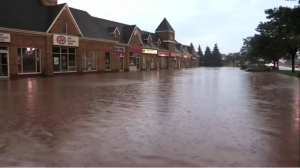 The commercial sector suffered as well during the flood – no one is hearing how they dealt with the damage. “Emergency preparedness is something that every Burlington resident should be concerned about. We need to be confident that the City and the Region are prepared to take appropriate action during times of crises.”
 A Valentine Day event to get together and chill out and raise funds for further research. Tickets can be purchased online at WWW.EventBrite.ca – search for ‘Valentines Gala’ – or call 289-335-0329. Singles and couples welcome, senior and group discounts, 19+. * Transportation for seniors’ groups can be arranged.
The city has budgeted $4.5 million to do a study on what would have happened to other parts of Burlington had the same amount of raid dropped in Aldershot.
The HRASB hasn’t said what it is they want to independently research on nor have they set out a target as to how much money they need to raise.
Back in October, 2014 the HRASB wrote Regional Chair Gary Carr asking a number of questions.
Why, they wanted to know, did the representatives from the Burlington Flood Relief Foundation decline two invitations to attend sewer backup meetings thereby missing opportunities to connect with 350+ residents who were directly affected by sewage backup?
First, the organization was the Burlington Community Foundation and there job was to deal with two clearly defined groups of people: Those who did not have any insurance and those who were under-insured.
A meeting with 300+ people who didn’t meet these criteria would serve no purpose – and, the BCF was terribly over-worked dealing with those who did meet the criteria.
The members of HRASB and the people they represent have significant and justifiable complaints. The Regional government has basically stiffed them and failed to respond adequately to their real concerns. There is more detail on the HRASB web site at www.hrasb.com
There was an On line petition requesting a Town Hall meeting; that went nowhere. Everyone who signed the on-line petition also sent an email to Regional Chair Garry Carr – that didn’t produce any results either.
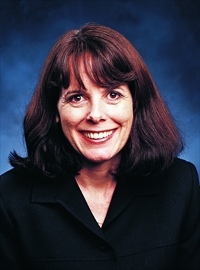 Jane MacCaskill, CAO for the Region felt that elections got in the way of meeting the needs of residents whose homes were flooded. Regional CAO Jane MacCaskill published a press release in a local newspaper saying there would not be any public meetings with a municipal election taking place. For some reason MacCaskill feels the administration of a municipal government comes to a complete stop just because there is an election taking place,
The election is over – so now is there going to be a meeting? Thorpe doesn’t appear to be holding her breath.
There have been a few very poorly promoted Public Information events that were reportedly poorly attended.
Christina Thorpe is pushing for better transparency and more accountable. She thinks that the three law suits that have been filed against the Region for the way they handled the flood matters might be why they are being kind of quiet.
The people who lost so much due to the flood have big hearts – and they want to share the love on Valentine’s Day – and then use the money they raise to do some serious research. There is nothing more effective than a grass roots organization committed to their cause.
Related articles:
Open letter to the Regional chair – he didn’t respond.

 By Staff By Staff
January 27, 2015
BURLINGTON, ON.
This is about as dirty as it gets.
Anyone who responded to this email will lose most of what they might have had in a bank account.
The email read like this:
VALUED CUSTOMER, A new Electronic Statement is available. Click Here to sign and update your details for Year 2015.
To review or change your email notification preferences, go to “Profile and Preferences” once inside Online Banking and then select “Email address and preferences”.
Please do not reply to this email, as it was sent from an unmonitored account.
BMO Online is offered by Bank of Montreal.
The Gazette banks’ with BMO. The thief used an email address that is linked to our domain. Somehow they got into the data base that lists the email addresses we have.
Had we clicked on the link they offered – it would have been “toast” for us.
Read email that relates to your banking very, very carefully. If in doubt – don’t.

 By Mark Gillies By Mark Gillies
January 27, 2015
BURLINGTON, ON.
Part 1 of a 2 part feature
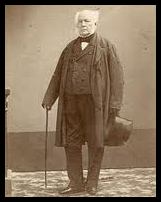 Sir Allan Napier MacNab was a wealthy lawyer, a Prime Minister, a co-founder of The Great Western Railway, including business partner and close friend of Peter Carroll. Here’s a question for you. When Hamilton’s Sir Allan Napier MacNab the wealthy Prime Minister of Upper Canada, from 1854 to 1856, went dining at a castle in Aldershot, where did he always go?
If you said, Rock Bay, consider yourself a genius. If you have never heard of Rock Bay, don’t feel bad, you are not alone. This is just one more of Burlington’s greatest treasures, regrettably, forgotten over time.
Rock Bay was the first stone castle-like mansion built in the Aldershot area during the early 1850s, by one of Canada’s wealthiest men, Mr. Peter Carroll. Many at the time referred to his residence as Carroll’s Castle, because it did resemble a castle.
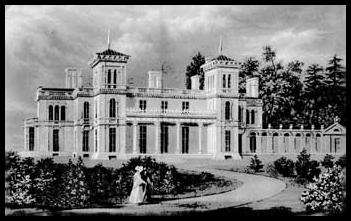 Dundurn Castle was built for Sir Allan MacNab and completed at a cost of $175,000 in 1835. This artist’s impression shows us what Dundurn Castle looked like in this same year. Dundurn Castle, which we are more aware of, is located at the western end of Burlington Bay on land named Burlington Heights. This beautiful grandiose home built for Sir Allan MacNab, over a 3 year period, was completed in 1835, at a cost of $175,000. We just don’t know about its neighbour, Rock Bay Castle, nor do we know much about Peter Carroll.
What was it that these men had in common? Allan MacNab and Peter Carroll both attained enormous wealth and great power. They were best of friends and business partners. Allan MacNab was a lawyer, but amassed his wealth in land speculation. Peter Carroll was a land surveyor by profession, eventually retiring from this field, in favour of establishing a construction company that built and owned major toll roads across the colonial province. To say the least, this career move was extremely lucrative. Road construction and tolls were the catalysts that launched Peter Carroll into new wealth. Among the many roads in Upper Canada that Peter constructed and owned were these familiar local routes; Waterdown Road, Plains Road (then called the Hamilton and Nelson Gravel Road) and Carlisle Road, plus most roads surrounding Hamilton. Before retiring from land surveying, Peter was responsible for the creation of the grid pattern street layout in Hamilton, a contract offered to him by his good friend, George Hamilton, the founder of Hamilton, Ontario. Peter, under a similar contract, also surveyed the entire Burlington Bay.
Three great minds work together to amass their fortunes
Allan MacNab and George Hamilton were already longtime boyhood friends, both born and raised in Niagara-on-the-Lake. These two men rose to prominence mainly from their efforts in battles during the War of 1812. Helping to defeat the American invasion at Queenston was their crowning achievement in the military. Allan MacNab was knighted by Queen Victoria. Peter Carroll served as a lieutenant-colonel in the militia in these same battles. This is most likely where he first met the other two men, prior to all three setting out seeking fame and fortune after the war ended.
It was basically these three men, after the war, who worked together to shape the future of Hamilton, plus the surrounding areas, including Aldershot. All three men acquired massive tracts of land in this same area, and even abroad. Peter Carroll for one, had extensive land holdings in Iowa and Illinois. All of this land provided the three landowners with unbelievable wealth. These three men influenced the future direction for the Province of Upper Canada, mainly through politics.
Peter Carroll selects a beautiful setting to build his mansion
A spectacular view from Burlington Heights looking east towards Lake Ontario, was the best property for Allan MacNab to build Dundurn Castle. Peter Carroll, not to be outdone, one day, also wanted to have a palatial home with a view overlooking the same Burlington Bay. Unfortunately, the Dundurn Castle site was already taken. As Peter continued to work his way into the power brokers’ circle, with his wealth continuing to dramatically increase, he finally decided it was time to build, and purchased a 40 acre tract of land on the northwest side of Burlington Bay.
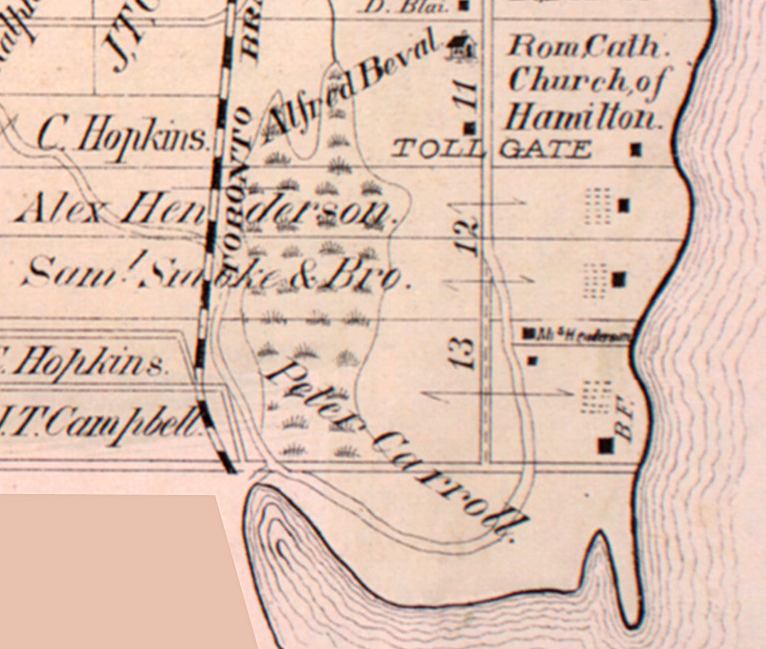 This old land map shows us where Peter Carroll’s property was located in Aldershot. Today, the same property is where Woodland Cemetery, the Royal Botanical Gardens and the Plains Road curve are located. It was not uncommon for men of great wealth to showcase their success with massive homes. Peter was shrewd enough to not upstage his friend and mentor, Sir Allan MacNab, by building a larger mansion, despite possessing enough wealth. Peter’s home would be on a smaller scale, but would resemble a castle in England. Peter hired an English architect who specialized in manor homes. The architect was brought over to design his new home. The land that Peter Carroll purchased is now occupied by Woodland Cemetery, the Royal Botanical Gardens, and the Plains Road curve in front of the RBG headquarters. The massive stone structure began its construction in the late 1840s. Cut stone was shipped in from a quarry located in Queenston. The mansion was finally ready for occupancy in 1855. The beautiful estate featured a port cochere, stables, outbuildings, a mammoth entrance gate, and small guest lodges located just inside the gates.
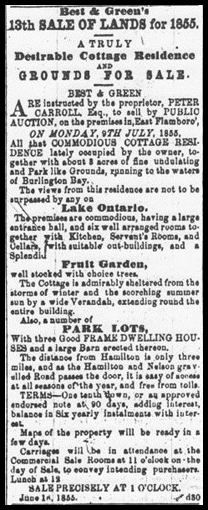 The Bayview cottage was put up for sale by auction in 1855 when Rock Bay was ready for occupancy. The advertisement describes the building, and the grounds available for purchase. Part of the estate was set aside for farming. Peter Carroll has been identified as one of 2 people to introduce commercial peach farming into Upper Canada. Oak trees were planted on either side of the long winding drive heading towards the mansion, beginning when you turned off from the Hamilton and Nelson Gravel Road. Many of these same oak trees planted on Peter Carroll’s estate are now over 160 years old, and if you position yourself correctly on the grounds of Woodland Cemetery, it is possible to follow the route of the original laneway right to the front entrance of Rock Bay. Peter’s first home in the area, was an oversized board & batten wooden cottage, called Bayview. This building was located on the same property, and was constructed a few years before the mansion was built. When Peter was ready to move in to the larger premises, Bayview was put up for sale by auction.
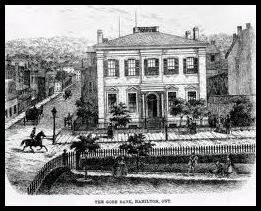 Peter Carroll was on the Board of Directors for several corporations, including the Gore Bank. This drawing is the Gore Bank office in Hamilton. Peter Carroll sits as a Director on two different banks
As Peter became more influential and powerful, he was invited to be on the Boards of several corporations, including the Bank of Brantford and the Gore Bank. In those days banks issued their own currency in the form of bank notes, but they were actually promissory notes.
A Great Western Railway “Founding Father”
While the mansion was still under construction, and even after Peter Carroll moved in, Sir Allan MacNab and Peter Carroll continued to move along fairly quickly in the business world. They believed a railway was needed to help open up southwestern Upper Canada for more European settlers who were arriving in increasing numbers.
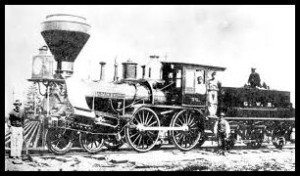 The Great Western Railway built train stations, bridges and track all across southwestern Upper Canada. This is a rare photograph of a very early Great Western Railway locomotive, tender and cars. One of the greatest achievements for these men, was to finally receive a charter from The Parliament of Upper Canada in 1845, to create the Great Western Railway, 7 years before The Grand Trunk Railway was incorporated in 1852. The new railway company began construction of trains stations, rail lines and bridges, mainly in southwestern Upper Canada. Rail service began in 1853. Sir Allan MacNab became President, and a group of men, mainly prominent lawyers, including Peter Carroll formed the first Board of Directors.
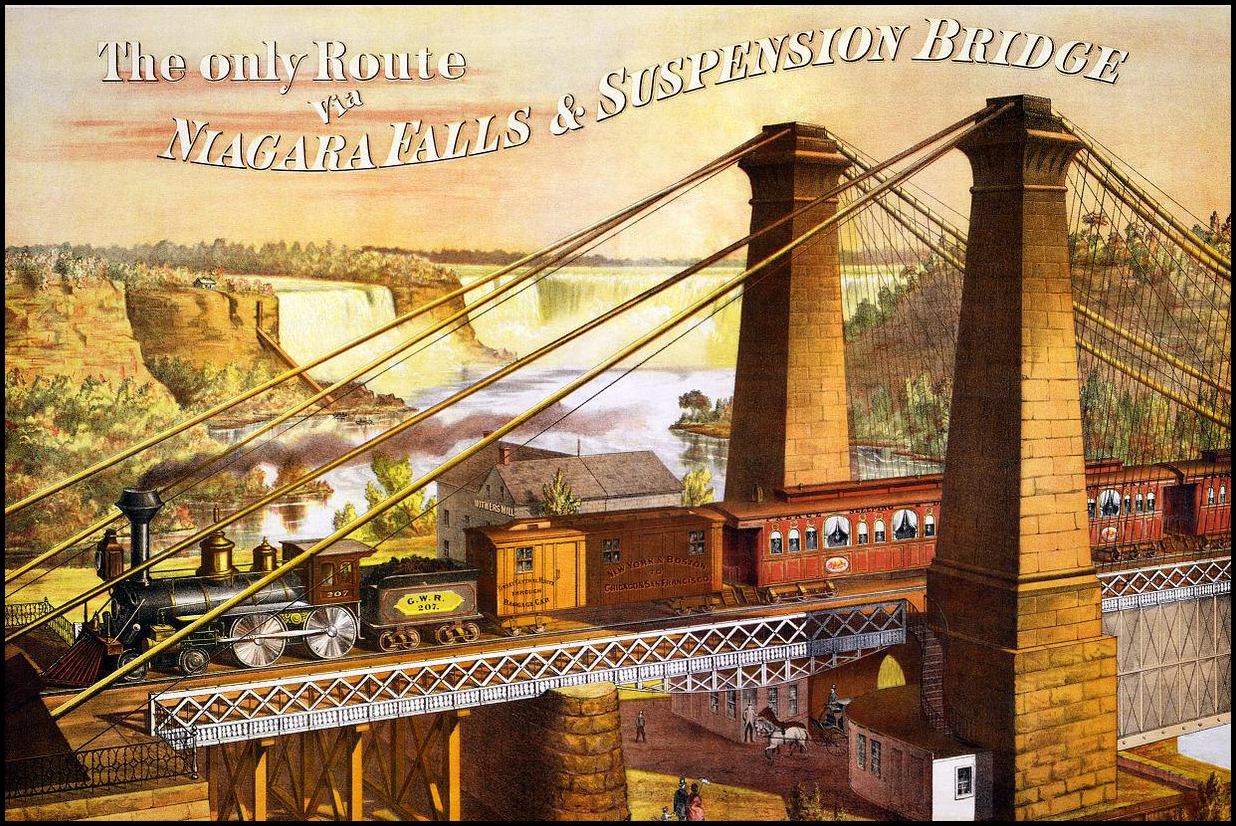 The Great Western Railway was the first in Upper Canada to establish itself as a major player in the market. The drawing of the suspension bridge, a marvel for its time, shows a GTR train crossing. Peter Carroll was on The Board of Directors for the Niagara Suspension Bridge Company and The Great Western Railway Company. The Niagara Suspension Bridge
Even back in the early 1840s, before their railway charter was awarded, these men realized accessing the bigger American market was going to be key for their financial success. The Great Western Railway Board believed the rail line should one day connect to the United States by a bridge. With that decision made, Peter Carroll became a Director of the Niagara Suspension Bridge Company of Canada. The International Bridge Company of New York was the second company involved with the bridge construction. The two companies would have joint ownership. This first railway suspension bridge in North America was built across the Niagara Gorge, an expanse of 800 feet. The suspension bridge when it opened in 1855 was considered to be an engineering marvel, for its time.
In part 2 of this 2 part feature find out what happened over 100 years ago to this beautiful castle-like mansion. over 100 years ago? See 2 very rare old photographs of what Rock Bay Castle looked like. Whatever happened to Peter Carroll? Why is he not in the history books?

 By Mark Gillies By Mark Gillies
January 22, 2015
BURLINGTON, ON
Part 3 of a 4 part feature
Burlington in transition
Under Chief Smith’s watch, Burlington continued to grow rapidly, as it continued to transition itself from an agricultural community to a suburban bedroom town. From around 1916 to 1941, the little town grew to almost 4,000 inhabitants. One man that was instrumental in feeding construction materials to the exploding housing market was Jacob Cooke. Jake manufactured concrete blocks starting in 1935.
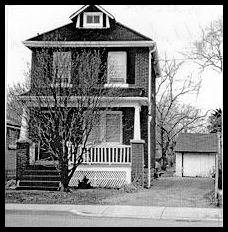 Jake Cooke started his concrete block business in 1935 at his residence in his garage. The house was originally numbered as 3 New Street, and was at the corner of Martha Street. This Burlington manufacturer grew to be one of the largest of its kind in North America. The one man factory was located in Jake’s garage beside his house on New Street, at the corner of Martha Street. The demand was so high for Jake to supply the house builders with concrete blocks, that as a one man operation, Jake was churning these blocks out almost nonstop around the clock, 7 days a week. As with most factories, big or small the noise was unbearable, and Jake’s neighbours on New Street and surrounding streets were complaining. Chief Smith was at Jake’s home continually handing out warnings and fines. Jake consistently apologized, yet persevered, paying out the money for the fines. Today, it’s widely accepted that a great many houses in Burlington with concrete blocks in their basement walls were manufactured by Jake Cooke’s second plant located in Aldershot. One day Jake Cooke’s house on New Street was also demolished, an all too familiar practice in Burlington.
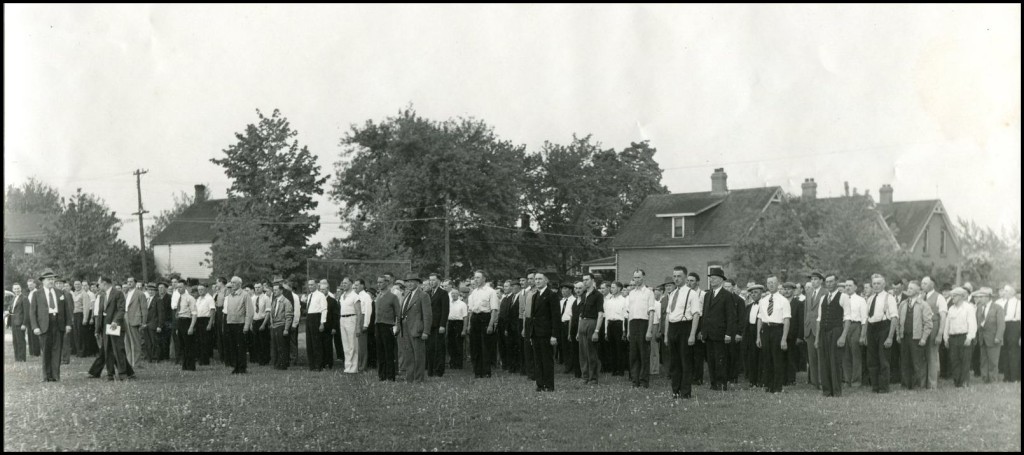 The men of Burlington gather as the Home Guard under Chief Smith’s guidance and get ready for a drill in 1940 to prepare for any disaster that might happen during World War 2. The Chief defends Burlington with the Home Guard
In 1940, as the war began, it was decided that Burlington needed to be prepared locally for anything destructive that might happen, perhaps sabotage, or something worse. The Burlington Home Guard was created. Chief Lee Smith was one of the founding organizers, and all Burlington men of legal age, were to register on a voluntary basis. A counting of all local firearms was to recorded. The Chief was ready for anything. “O Canada, We stand on guard for thee”.
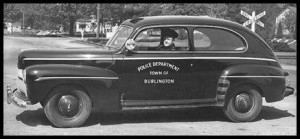 Ken Scott is behind the wheel of the new 1947 Ford Coupe Police Cruiser, the first one for the department. The photo was taken on Lakeshore Road at the corner of Maple Avenue, by the railway tracks. If you look behind the rear of the trunk you can see part of the word “Burlington” in a floral garden on a slight hill, planted there by Spencer Smith and the Burlington Horticultural Society, as part of their beautification of Burlington mandate. Burlington’s first Police cruiser
Chief Smith continued to work hard and grow his department. It took a while, but the Town Council under the leadership of Mayor Edwin Leather, took the Chief’s request seriously. The Police Department should now have their own cruiser. Officers would no longer be required to use their own vehicles to drive to accidents, perform high speed chases, apprehend criminals, or transport vomiting and urine soaked drunks off to jail. In late 1946 or early 1947 Chief Smith and his department proudly took possession of their first police cruiser. The boys down at the station were pretty excited and happy about this new arrival. The vehicle was a brand new 1947 black 2 door Ford coupe and it actually had a working siren on the roof. Children in the neighbourhood loved to hear the siren’s sound, and the boys on the force loved to turn it on for the kids’ amusement. Chief Smith, on the other hand, was not amused. Still, life was pretty good at the Burlington Police Department in 1947.
Burlington’s finest from 1953 remembered.
By 1953, Chief Smith’s Police department had grown, now there were 8 men, as the town continued to expand. The town had also taken another dramatic jump in population. Now, Burlington had over 6,000 living within its boundaries. Chief Smith had excellent instincts about people, and always personally selected each new officer. All new officers were to possess outstanding leadership characteristics and stellar people skills. Any of his men should possess the abilities to one day be a future Police Chief or a community leader.
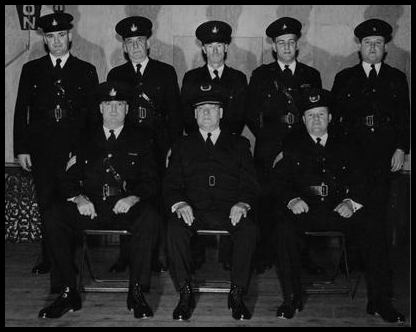 These 8 police officers in 1953 were Burlington’s finest. Standing: L-R, Sam Peer, Tom Smith, Art Turcotte, Charlie Parsons & Tom Oliver. Seated: L-R, Lisle Crawford, Chief Lee Smith & Ken Scott. The Police Chief believed in his men, and they believed in him. The bond between them was very tight. The “Magnificant 7” never let their Chief down. The department under Chief Smith’s command consisted of Sam Peer, Tom Smith, Art Turcotte, Charlie Parsons, Tom Oliver, Lisle Crawford, and Ken Scott. Some of these officers went on to have long rewarding careers with Halton Regional Police Services. Lisle Crawford in 1953 was Chief Smith’s sergeant, and when Lee retired in 1956, at the age of 71, Deputy Chief Crawford became Burlington’s next Chief of Police.
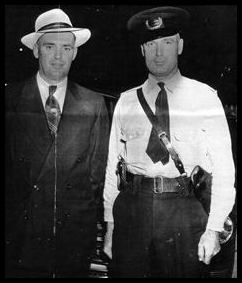 Sam Peer is on the left, and Lisle Crawford is in uniform. Lisle was promoted to became Burlington’s Police Chief following Chief Smith’s retirement in 1956.  Sam Peer was active in the community, also serving as a volunteer fireman, in addition to his duties as a Burlington Police Officer. Sam Peer, proud to be known as an “old school” officer passed away in 1987. Sam was an outstanding Officer, and even his son James was so inspired by his father, that he too, followed in his father’s footsteps and became an OPP Officer. Sam was so community minded, he even served as a volunteer fireman. Charlie Parsons after returning from the war, initially found work as a bus driver, then joined the police department in 1948.
 A former Citizen of the Year, Charlie Parsons served his community well, as a Police Officer, a volunteer fireman, and 30 years with the Burlington Teen Tour Band. Many in Burlington will remember Charlie as a fixture for 30 years with Burlington’s Teen Tour Band, devoting countless hours with them, as an Equipment Manager and driver for the band’s truck, Charlie travelled everywhere with the band. The kids in the band affectionately called him “Uncle Charlie”. Always willing to help, Charlie served as a volunteer fireman too. Gary Parsons, Charlie’s son was so proud of his father, he too, felt the call to become a Halton Regional Police Officer. In 1957 Charlie was awarded Burlington’s Citizen of the Year. The City was saddened when Charlie at the age of 60 passed away in 1983, the same year he retired. Fortunately, for Charlie, he did get to attend his huge retirement party held at King’s Court on King Road. The place was packed. It seemed like everyone was there. Charlie will never be forgotten.
Lisle Crawford was Police Chief in 1959, when a bank robbery at the corner of Brant and Caroline Streets resulted in a gun fight between the robbers and the police. An unbelievable 45 shots were fired before the 2 men were apprehended. Lisle retired as Chief in 1968, and sadly Chief Crawford passed away in 1983.
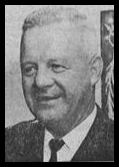 Ken Scott was promoted to Deputy Chief after Chief Smith’s retirement, and after amalgamation Ken became an Inspector with the newly amalgamated police department. Ken Scott was promoted to Deputy Chief, and in 1958 when Burlington, Aldershot, and Nelson Township amalgamated, Ken became an Inspector for the newly integrated department. It was actually Ken Scott who became the first officer to get behind the wheel of the department’s new 1947 Ford. Ken recalled when he retired around 1968 or 1969,that back in the early days when he joined the department full time in 1943, all 4 officers were working 6 days a week doing 12 hour shifts, even doubling as dog catchers, and licence fee collectors. Ken fondly recalled, they were rough days, but good days. Ken Scott passed away in 1986.
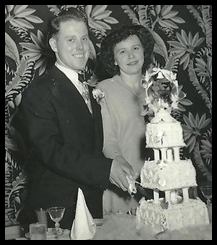 Constable Tom Oliver marries the love of his life, the lovely Dorothy Daniels. Tom, a Staff Sergeant retired from the Halton Regional Police Services around 1991. One of the men who the Chief hired as a new police officer in 1946, following the war, was 23 year old Fred Oliver, ex-soldier and ex- military police officer who was the older brother of fellow Officer Tom Oliver. Tom had a full rewarding career in policing and would later retire as a Staff Sergeant with Halton Regional Police. Tom passed away in 2006.
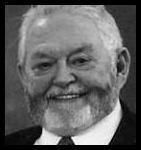 Fred Oliver was the older brother to Tom Oliver. Fred eventually became Oakville’s Chief of Police and Deputy Chief with the Halton Regional Police Services, and after retirement, Fred had a second career as a politician serving on Oakville and Halton Regional Council. Fred stayed for one year in Burlington, and moved on to head up the Trafalgar Township Police and become its Chief at 25 years of age, making him the youngest Chief in Ontario. Fred was involved at this same time in the famous bank robbery shootout on Brant Street, firing 2 shots at one of the robbers. With amalgamation in 1962, Fred was promoted to Chief of Police in Oakville, and in 1974 he was promoted to Deputy Chief of Halton Regional Police Services, retiring in 1980. A new career in politics led Fred into the Oakville and Regional Council political circle for many more years. Chief Oliver passed away in 2011.
The Chief’s priority was to keep Burlington’s youth out of trouble
The Chief was becoming more alarmed by the number of young people in the recently suburbanized Burlington, who were now beginning to get themselves into lots of trouble. They were good kids, just bored. During the 1950s, the town went from a population somewhere around 6,000 in 1950, and in the same decade, Burlington’s population would top up at around 47,000 by 1960. Burlington was experiencing a huge population explosion. During the Chief’s time in office, the population came very close to being a staggering 25 times greater than when he first began his career in Burlington. In this bigger town, there wasn’t too much for these teenagers to do in those days.
The kids were starting to hang around the new plazas that had just been built, or they were wandering up and down Brant Street in large numbers, yelling, swearing, fighting and just making a complete nuisance of themselves, all to the annoyance of those around. Teenage drinking, noisy cars and motorcycles, and lots more mischief from these kids was taxing the Chief’s patience.
The Chief instructed his officers to pay particular importance to these kinds of events, and to put a stop to their antics as quickly as possible, without bringing strong armed enforcement into it. The officers carried out the Chief’s orders efficiently and without any major incident, and as a result, once the young troublemakers were made aware that the Chief and his men meant business, and would not tolerate any misbehaviour, everything soon settled down to relative calmness, just the way the Chief liked it. Under the Chief’s watch, peace and tranquility was the way everyone liked it, and he kept it that way.

 By Staff By Staff
January 21, 2015
BURLINGTON, ON
Premier Kathleen Wynne announced today that the Ontario government is increasing wages for early childhood educators and front-line child care professionals in licensed child care settings.
Starting this month, Ontario is implementing a wage increase of $1 per hour for eligible child care workers in the licensed child care sector. Another wage increase is set for next year.
 The people who take care of the best future resource we have – get slightly more than a livable wage. Go figure. The increase will help close the wage gap between registered early childhood educators working in full-day kindergarten programs and child care professionals in licensed child care settings. Ontario’s investment to increase wages also supports efforts to recruit and retain highly qualified and talented educators, and supports parents in accessing safe and reliable care for their children.
It’s a start – now if the province would look seriously at a plan similar to the one in Quebec where child care is affordable – there will be more job opportunities for child care workers as well.

 By Staff By Staff
January 21, 2015
BURLINGTON, ON
Adults understand the relationship between nature and the environment – well some of them do. But how do you get that connection across to the pre-teens and the teenagers in the house?
 Snowy Owls are expected to show up in even higher numbers than last year. Young people have a connection with nature – they will stop and watch a hawk swoop in and grab a smaller animal from the ground. The will even marvel at an owl as it swoops from the top of a telephone pole to clutch a mouse scurrying through a field.
How do you get them to dig a little deeper and come away with an understanding that was based on an experience they had?
Bird Studies Canada does what they call for the Great Backyard Bird Count (GBBC). The 18th annual count is taking place February 13 through 16.
Anyone in the world can count birds at any location for at least 15 minutes on one or more days of the count and enter their sightings at www.BirdCount.org.
The information gathered by tens of thousands of volunteers helps track changes in bird populations on a massive scale.
 The GBBC is a joint project of the Cornell Lab of Ornithology and the National Audubon Society with partner Bird Studies Canada. The GBBC is a joint project of the Cornell Lab of Ornithology and the National Audubon Society with partner Bird Studies Canada.
Bird watchers fell in love with the magnificent Snowy Owl during the last count when the birds were reported in unprecedented numbers across southeastern Canada, the Great Lakes states, the Northeast, and down the Atlantic Coast. Expect Snowy Owls to show up in higher numbers during this year’s GBBC, too.
“It’s called an ‘echo flight,'” explains Marshall Iliff, eBird Project Leader at the Cornell Lab of Ornithology. “After a huge irruption like we had last winter, the following year often yields higher-than-usual numbers as well. The abundance of lemmings that produced last year’s Snowy Owl irruption likely continued or emerged in new areas of eastern Canada, more owls may have stayed east after last year’s irruption, and some of last year’s birds that came south are returning.”
 “This may also be a big year for finches,” notes Audubon Chief Scientist Gary Langham. “GBBC participants in North America should be on the lookout for larger numbers of Pine Siskins and redpolls. These birds also push farther south when pine cone seed crops fail in the far north of Canada.” “This may also be a big year for finches,” notes Audubon Chief Scientist Gary Langham. “GBBC participants in North America should be on the lookout for larger numbers of Pine Siskins and redpolls. These birds also push farther south when pine cone seed crops fail in the far north of Canada.”
Bird watchers from 135 countries participated in the 2014 count, documenting nearly 4,300 species on more than 144,000 bird checklists–that’s about 43% of all the bird species in the world! In addition to the U.S. and Canada, India, Australia, and Mexico led the way with the greatest number of checklists submitted.
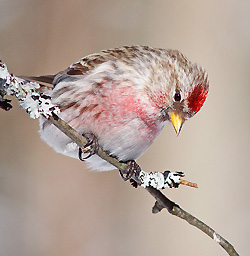 Common Redpole “We especially want to encourage people to share their love of birds and bird watching with someone new this year,” says Dick Cannings at Bird Studies Canada. “Take your sweetheart, a child, a neighbor, or a coworker with you while you count birds for the GBBC. Share your passion and you may develop a brand new bird watcher!”
The Great Backyard Bird Count is a great way for people of all ages and backgrounds to connect with nature and show some love for the birds this Valentine’s Day.
Participation is free and easy. To learn more about how to join the count, download instructions, a slide show, web buttons, and other materials, visit this website: While you’re there, get inspired by the winning photos from the 2014 GBBC photo contest.

 By Staff By Staff
January 21, 2015
BURLINGTON, ON.
The city wants to make the streets look nicer. A number of years ago they installed really nice looking bike racks – they were attractive – so much so that many people didn`t use them – they didn`t know they were bike racks.
 Lovely public art – it’s a bike rack. Hard to tell what its purpose is – needs a small sign – Park your bike here. Margaret Lindsay Holton, a local artist, tells of a person she saw chaining their bike to a pole that was beside one of the bike racks – the rack was so attractive people didn`t realize what they were for. “That was one of those occasions I wished I had had my camera with me” said Holton.
At some point the city might add small signs to the racks – saying what they are – they are very nice.
Through its public art program, the City of Burlington is inviting the public to provide suggested locations and themes for a series of local murals and is offering three ways to comment between now and Feb. 6.
“This is a great initiative that will Increase local artist participation in the City of Burlington’s public art program,” said Angela Paparizo, manager of arts and culture. “We’re excited to engage residents in the creative process through mural site selection and community storytelling and hope they will take advantage of the opportunity to shape art in their community.”
Murals are a new thing for Burlington. There was a poster put up on a building – the garage at the foot of Locust Street – that has great potential as a mural site.
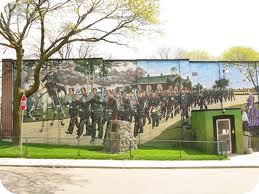 Scarborough, Ontario went for murals in a big way. Might Burlington see work of this quality? Scarborough took to mural art in a big way and has done a great job. It will be interesting to see what the Burlington art community does.
There is a fine mural on the Flat Iron building on Front Street in Toronto that has stood the test of time. Unfortunately the city mural program does not apply to private buildings.
The Burlington Mural Project is designed to tell local stories using local artists.
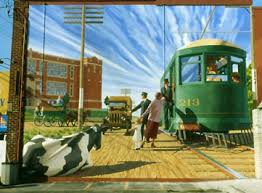 Could this have been Burlington when it had radial lines in the city? The program has a budget of $5,000 to $10,000 for each mural and will commission small to medium-scale murals throughout the city, with one mural location and story selected for each of Burlington’s six wards.
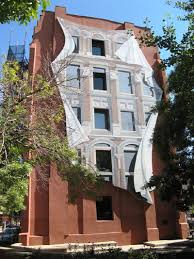 This mural on the Flat Iron building on Front Street in Toronto is on a private building. Burlington has decided its mural program will be on just city buildings – pity. These submissions will be reviewed by the city’s Public Art Implementation Team (PADIT) and a jury of citizens. Locations and artists will be chosen based on public input. The murals will be open exclusively to local Burlington artists. Free learning opportunities will be offered to artists who may not have experience creating public art and/or murals.
This program was developed in consultation with members of the local arts community. In October 2014, a brainstorming session was held with members of the local arts community. Based on this session and feedback, a Program Guide has been developed. Click here to access a copy.
Artist applications for the selected mural projects will be released in late February 2015.
The city will have a Public Art Booth at the Lowville Winter Games on Sunday, January 25 – share your ideas.
There is no limit on the number of submissions per resident.

 By Staff By Staff
January 15, 2015
BURLINGTON, ON
Getting a visit from the fire fighters is just fine – as long as they are not coming up the driveway with sirens blazing.
During the summer the Burlington Fire Department conducted home visits as part of its rural fire safety program, a public education campaign started in 2013 to test residential smoke and carbon monoxide (CO) alarms. The goal of the program is to keep residents safe by ensuring homes are protected and comply with Ontario smoke and CO alarm laws.
They were back in the rural part of the city with the biggest loot bag you will ever see. The fire department called them “home fire safety prize packs”.
“We were able to visit about 1,700 homes over the course of the program and talk to many residents about home fire safety,” said Chief Fire Prevention Officer Joe Wintar. “Residents that participated in the home visit were entered into a draw to win a home fire protection gift basket valued at $250.”
“We appreciate people taking the time to welcome us into their homes,” said Public Education Officer Kim Sopko. “Winning homeowners received a prize package that includes essential home fire protection items such as a smoke and CO alarm, a home escape ladder and fire extinguisher.”
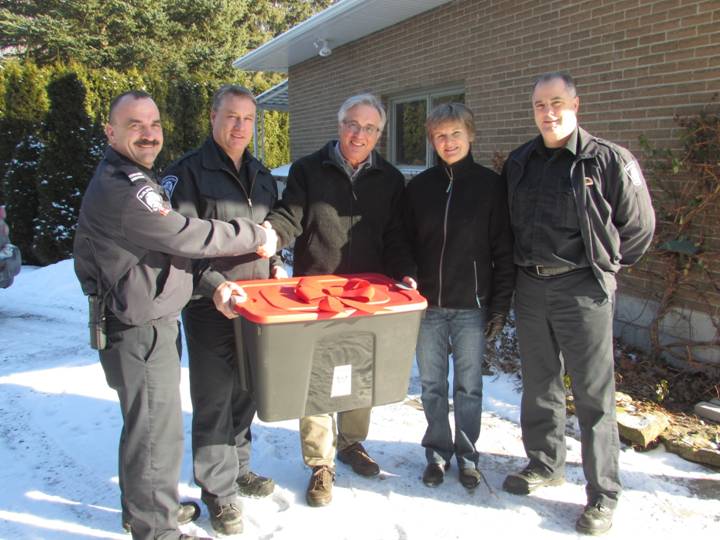 Right to left: Acting Captain Dave Meehan, Firefighter Rod Mchaffie, residents Rod and Karen Yuzik, Firefighter Joe Savelli 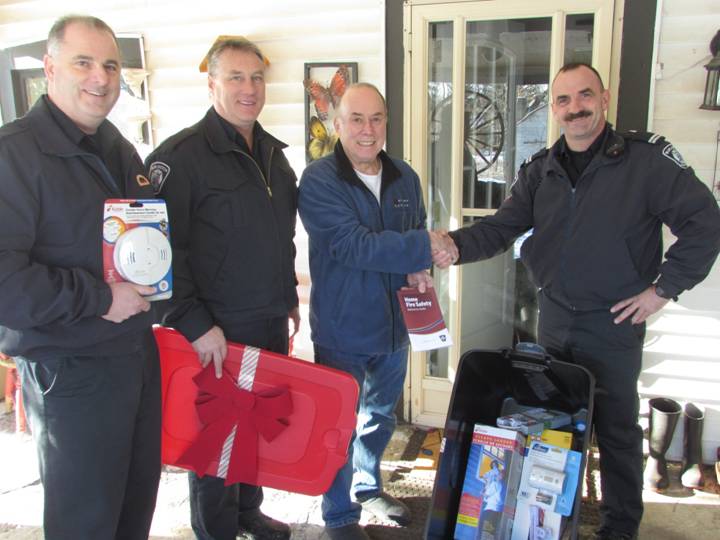 Right to left: Firefighter Joe Savelli, Firefighter Rod Mchaffie, resident Maurice Davidson, Acting Captain Dave Meehan
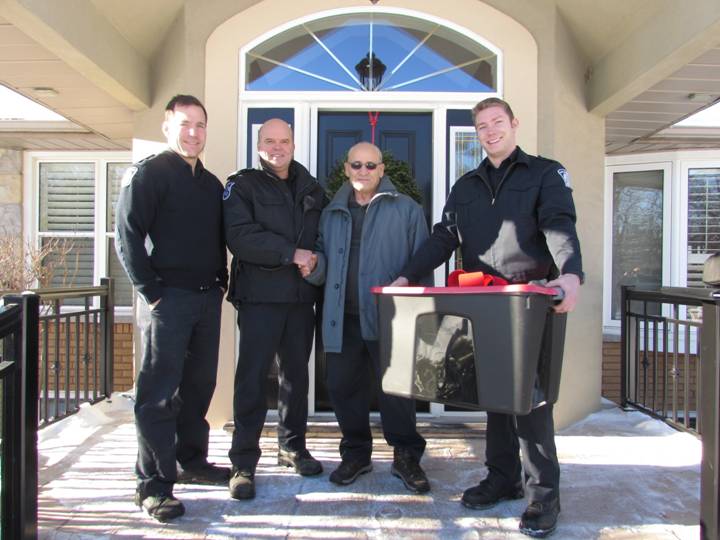 Right to left: Firefighter Tim Hart, Acting Captain Shawn Gilroy, resident Nick Basile, Firefighter Alexander Zijlstra
If residents were not home at the time of the visit, they can still schedule a free in-home fire safety visit by calling 905-637-8207, ext. 6333 or emailing firedepartment@burlington.ca.
Follow @BurlingtonFire on Twitter and visit us on Facebook or at www.burlington.ca/fire or for more information on fire safety.

 By Walter Byj By Walter Byj
January 10, 2015
BURLINGTON, ON
The initial 2015 meeting of the Halton District School Board continued the ongoing process of how to make the pursuit of an education easier, more fun and more rewarding.
 Halton District School Board chair Kelly Amos represent constituents in Oakville. Halton School Board Chair, Kelly Amos, recommended that the HSTS (Halton Student Transportation Services) do a study into the start times of high school students from the current time to a new time of between 8:45 and 9:15 am.
Any such change in time would require realigning busing within the system. After a brief discussion, the board passed the motion requesting a report from the HSTS sometime in March.
They then passed an additional motion that called for the Director of Education to establish an ad hoc committee of trustees and staff to investigate a strategy to regularly recognize staff, student, community partnership and volunteer achievements. Recognition and positive feedback are always useful, but the bar should be set high.
This was followed with a presentation from Lucy Veerman, Superintendent of Business Services and Treasurer, on the revised estimates of the 2014/2015 operating budget. Lots of numbers, the good news is that the revised budget is showing a surplus.
 Any change in school starting times will mean major changes to bus schedules. Gerry Cullen, Superintendent of Facility Services followed with the status of the “Close the Gap” program. This program was initiated to realize and address the gaps between older and newer schools to meet program delivery needs. Priority would be given to the following projects:
1. Water bottle filling stations
2. Support for installation of classroom projection equipment (IT)
3. Library Services
4. Air conditioning and electrical upgrades to second and third floor area of schools
5. Special education rooms
Approximately $14.4 million dollars was allocated to the project.
A more detailed article will follow shortly with a dollar breakdown and rationale for the above programs along with the affected Burlington schools.
It was a two and a half hour meeting – that went reasonably well.

|
|
 By Staff
By Staff


























 These questions led to a discussion of class minutes (74), the length of the school day, travel time between classes and the overall school day. Every trustee at the meeting was a full participant – it seemed that each was learning something new.
These questions led to a discussion of class minutes (74), the length of the school day, travel time between classes and the overall school day. Every trustee at the meeting was a full participant – it seemed that each was learning something new.










 Two programs – a full scale beer tasting and pairing event – tickets are $125 each and then the Saturday session from noon to 11 pm – where you can taste a solid section of craft beers.
Two programs – a full scale beer tasting and pairing event – tickets are $125 each and then the Saturday session from noon to 11 pm – where you can taste a solid section of craft beers.





 Henrietta, after recovering from small pox, continued to live at Rock Bay. When she became too elderly to live there on her own, she went to live in Hamilton.
Henrietta, after recovering from small pox, continued to live at Rock Bay. When she became too elderly to live there on her own, she went to live in Hamilton.




























 The GBBC is a joint project of the Cornell Lab of Ornithology and the National Audubon Society with partner Bird Studies Canada.
The GBBC is a joint project of the Cornell Lab of Ornithology and the National Audubon Society with partner Bird Studies Canada. “This may also be a big year for finches,” notes Audubon Chief Scientist Gary Langham. “GBBC participants in North America should be on the lookout for larger numbers of Pine Siskins and redpolls. These birds also push farther south when pine cone seed crops fail in the far north of Canada.”
“This may also be a big year for finches,” notes Audubon Chief Scientist Gary Langham. “GBBC participants in North America should be on the lookout for larger numbers of Pine Siskins and redpolls. These birds also push farther south when pine cone seed crops fail in the far north of Canada.”













